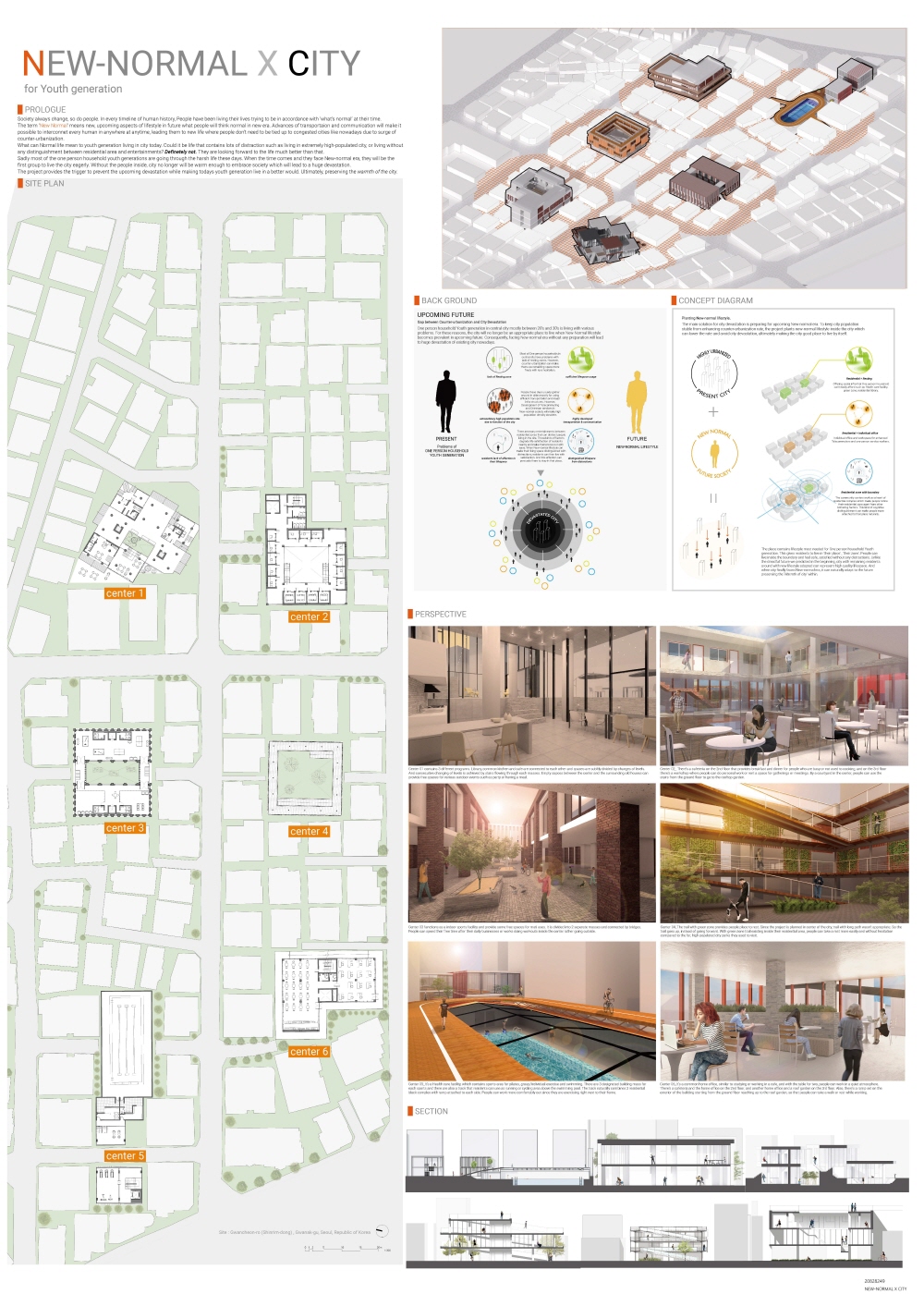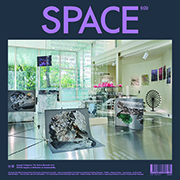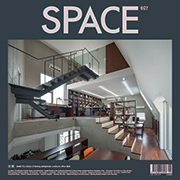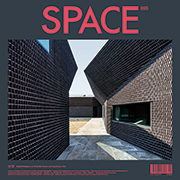The 33th Space Prize for International Students of Architecture Design
- Warmth in Architecture: Humanity -
SUBJECT
Warmth in Architecture: Humanity
Architecture is about creating space for human beings. The efforts self-evident and no one would doubt would raise a question on its endeavors. But modern architecture is engrossed in its functionality; presenting all its aspects it further gives way to amazing forms and efficiency in lieu of fundamental architectural value. Therefore, criterion for judgement for its success and failure relies on data and eye-opening exterior forms. Architecture slowly become a machine which has no warmth and introspection. No, rather it strives to resemble a machine. Breakthroughs in modern technologies in architecture boast itself and claims that nothing is impossible. At the present, efforts requires lots of man power; however, in the past it can be finished with ease. Now man believes in programs and machines rather than human beings. Everything can be converted into numbers. As a result, everyone come to expect more precise numerical final results. Modern architecture started out addressing social concerns and other significant issues of the period. However, as time passed the issues of social concerns diminished. In its place ubiquity and universality emerged as prevailing inclination. Gratified with the advancements in science and technology, society slowly disregarded the significance of human being. Accordingly, human beings are gradually alienated and cities have become drier. Most architect believes good proportion which is the basic of the architecture, which can be achieved through mathematical calculations. But, will it be true? Is the elegant proportions of the Parthenon achieved only through mathematical talent of the Greeks? If we state that everything comes from the hands, eyes, and keen sense from the master craftsman who have trained for an extensive period of time, it’s now obsolete. What do we have to revive at the present? What is the most important value we must bring forth to the center? Instead of the unique building forms, materials, and spaces; what values should architecture embrace once more? "The 33rd Space Prize for International Students of Architectural Design" wants to raise and ask the fundamental and past values towards Architecture and society.
JURY REPORT
Lim Hyung-nam, Noh Eun-joo
Architecture gains the meaning through its relationship with society.
"The warmth of architecture" means the reconciliation and communication with various surroundings. And 'Humanity' is a theme that is presented to reflect on the harmonious view of human beings in architecture as the basic attitude of an architect.
In particular, it was hoped that the prospective architects of the Space group International Student Architecture Award would have an opportunity to reflect on the current life in which the unexpectedly occurring corona from society, from human beings, and from relationships became daily life and consider the space to contain it. Contrary to expectations, only indirect commentary on the subject is delivered without a chance to meet in person, leaving a regret that it could not help with a deeper understanding.
Unexpectedly, many works were received, allowing us to meet work with serious concerns and thoughts on the subject. As much as possible, the criteria for screening were to works with their own views on the relationship between man and architecture and the city that allowed them to think about various approaches together.
Among the work submitted for the first review, 16 teams were selected focusing on works with clear interpretation of who will live, how to live, and what environment is proposed to the resident, rather than a general approach to the design of the collective housing in which the number of households is set on the target site and the unit floor is released.
In the second screening, the participants' presentations were heard and the works were selected as winners with more in-depth preparation and reflection in the design process. Most of the submissions were able to read their enthusiasm for the contest because of their excellent representation of subjects through 3D work, diagrams, and drawings that helped them understand the form and space. The completeness of the results is also important, but we focused more on 'do we start with a good question?' In particular, the Grand Prize winner praised the fact that the grand prize was more concerned about the communication method of each unit's generation living in collective housing, and the best prize winner expressed emotionally about the environment of the apartment he currently lives in.
Regardless of the type of award, give encouragement to the students who have studied a rather abstract subject for a long time and produced excellent results. Through this contest, I hope you will keep in mind the warm-hearted architecture and the warm gaze of the space where humanity recovers.
GRAND PRIZE
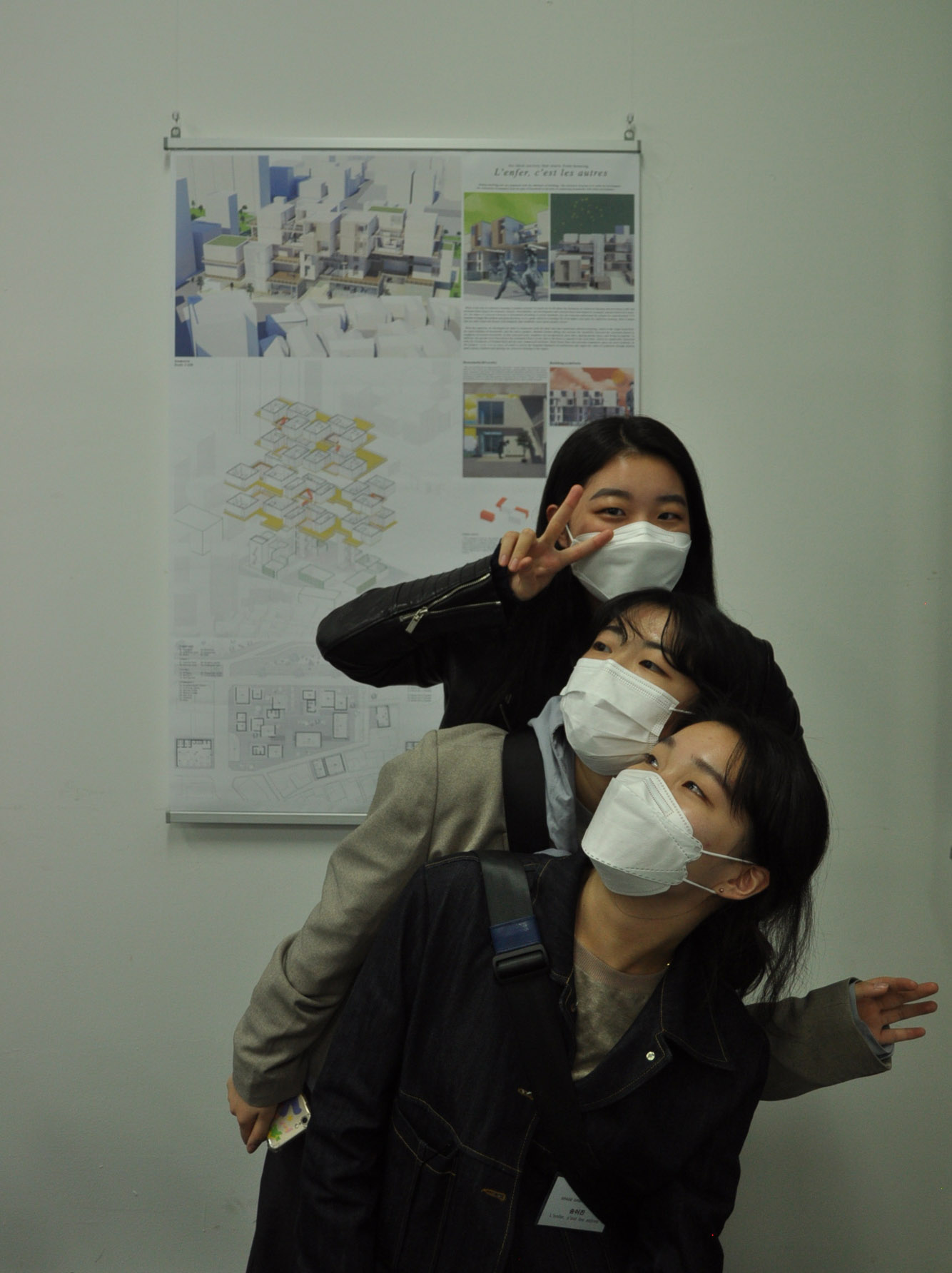
SONG, EO JIN+LEE, UI JEONG+JO, YUN JI
Chung-Ang University
L’enfer, c’est les autres
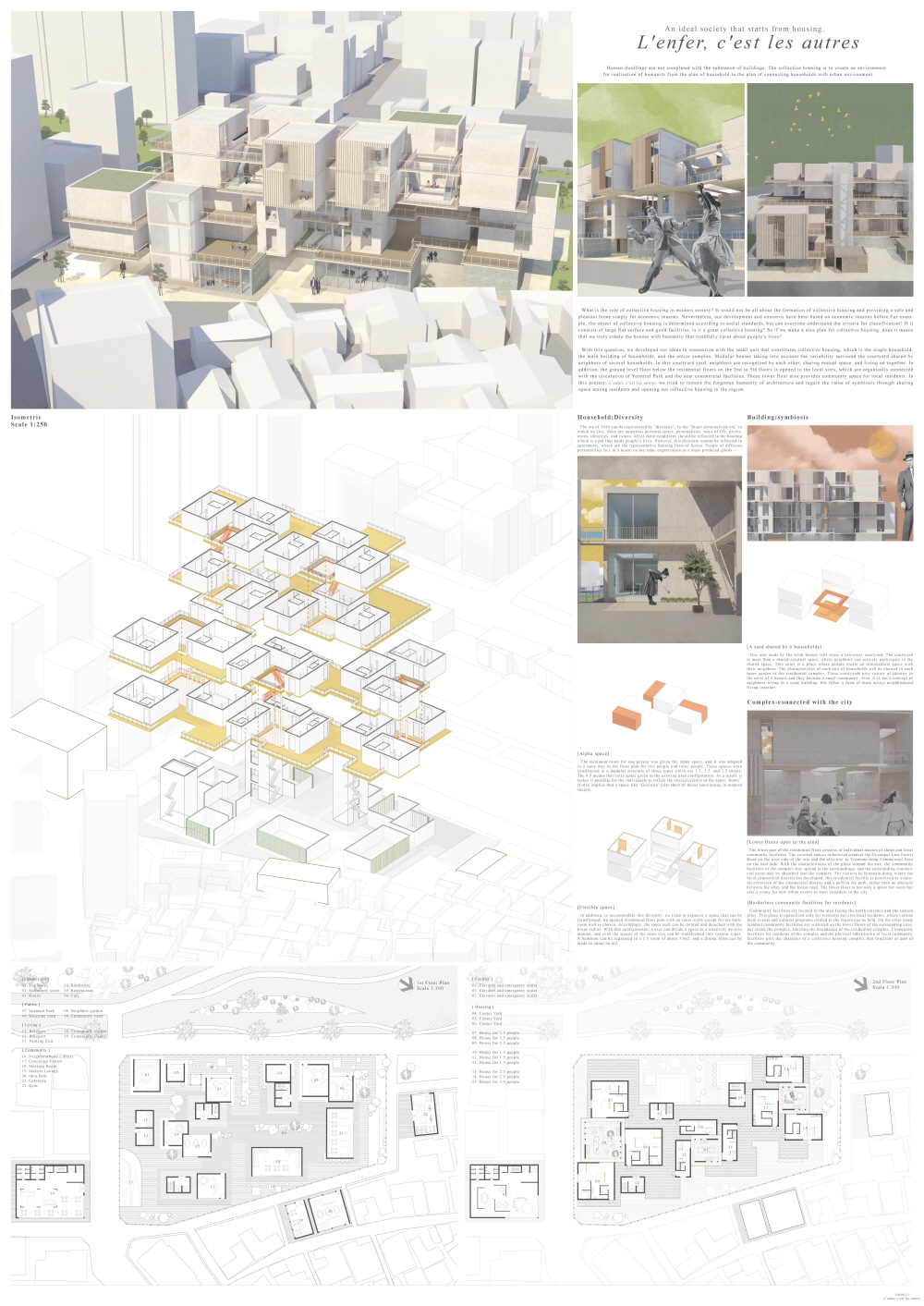 By reflecting on the essential meaning of collective housing, we can find humanity in it
By reflecting on the essential meaning of collective housing, we can find humanity in it
Collective housing is a gathering of various households, also it has frequent encounters and relationships between them. These features are substituted by spaces in collective housing, where users meet and relate to each other and where the warmth of architecture sprouts.
The spaces in the collective housing that connect from the individual's resident space to the outside of the complex are not only physical spaces where daily life takes place but also social exchange places for residents. Moreover, it is a place of infinite possibilities that progress from the most personal area to the space of the community. Therefore, the project is planned to place community places of different sizes from the living space where the user stays to the living area of a huge city. And those connected space works together to shine the value of the collective housing.
The questions on urban collective housing were the beginning of the project, which had so far been only a fragmentary and uniform scheme.
Can housing for an object survive in a society of diversity?
Why can't public spaces in multi-family housing become spaces for everyone?
Why did the complex become an island of the city?
We found a clue to a new multi-family house in the relationship between "individual and residential space," "small community making with neighbors," and "local community connecting the complex."
Residential units that give variability to the personal residence plan that enable to show each person’s unique characteristics and the central courtyard shared by small-scale units filled, and decks used by households. Also, community facilities on lower floors are open to the area and interact with the surrounding local site. Furthermore, as the community facilities are distributed and placed in adjacent areas to the main building, it blurs the boundary of the complex.
When the whole mechanism of a collective house is filled with the user's humanity and operates as one, we will be able to feel the warmth of true architecture in it.
Jury’s comment
I think it started with a good question. There was a clear sense of problem, concerns about the social function of architecture, and a trend of thinking that gradually expanded from individual to community. In particular, this work was outstanding in considering the sharing method that could actually be done from the size of the unit generation. It was also excellent that the lower floors of the building were expanded out of the land so that natural exchanges with local residents could take place.
PRIZE OF EXCELLENCE
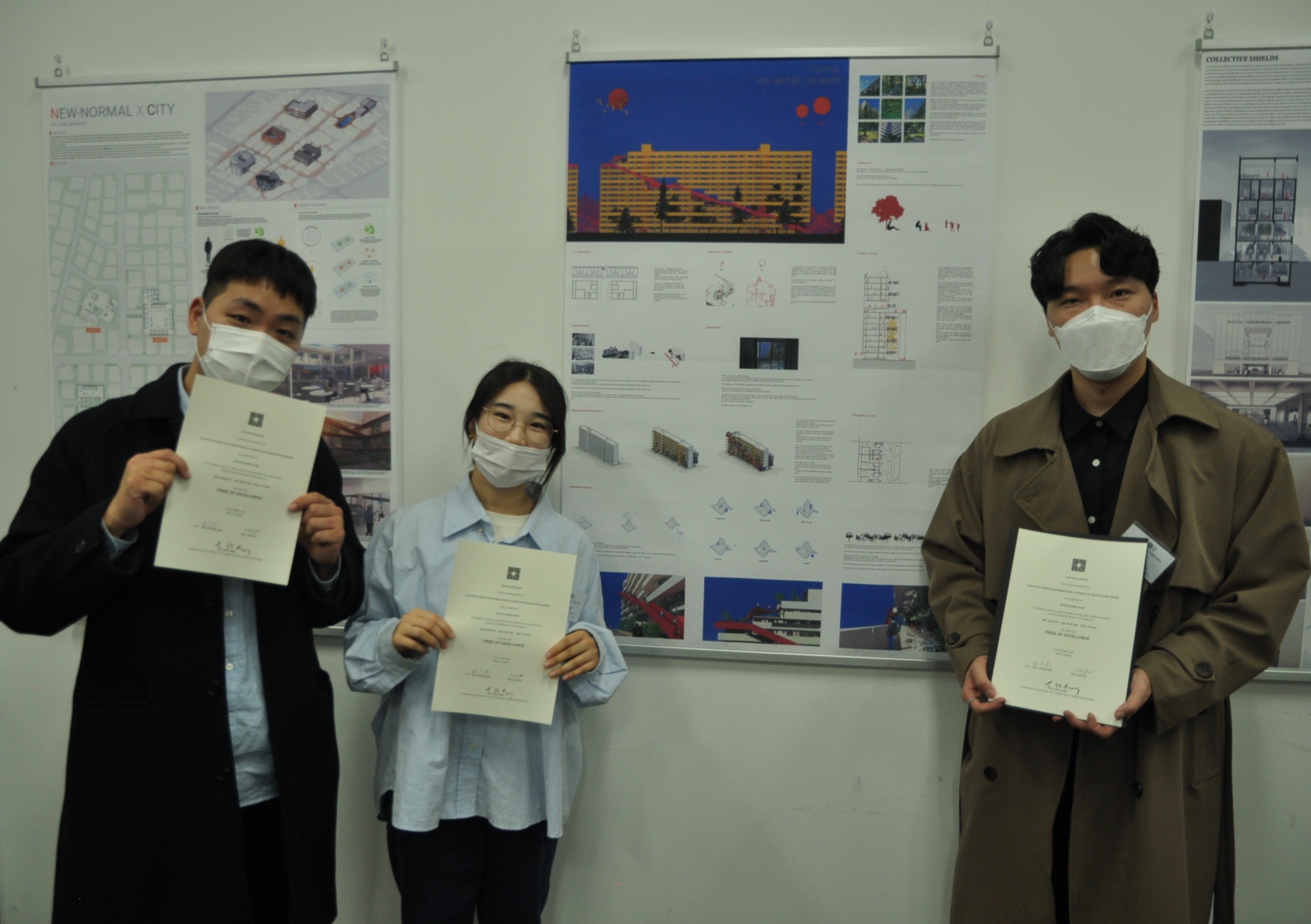
MIN, GEUN HO
LEE, WOO TAE
CHOI, JI HYUN
Dankook University
Eunma Apartment, One and All as a part
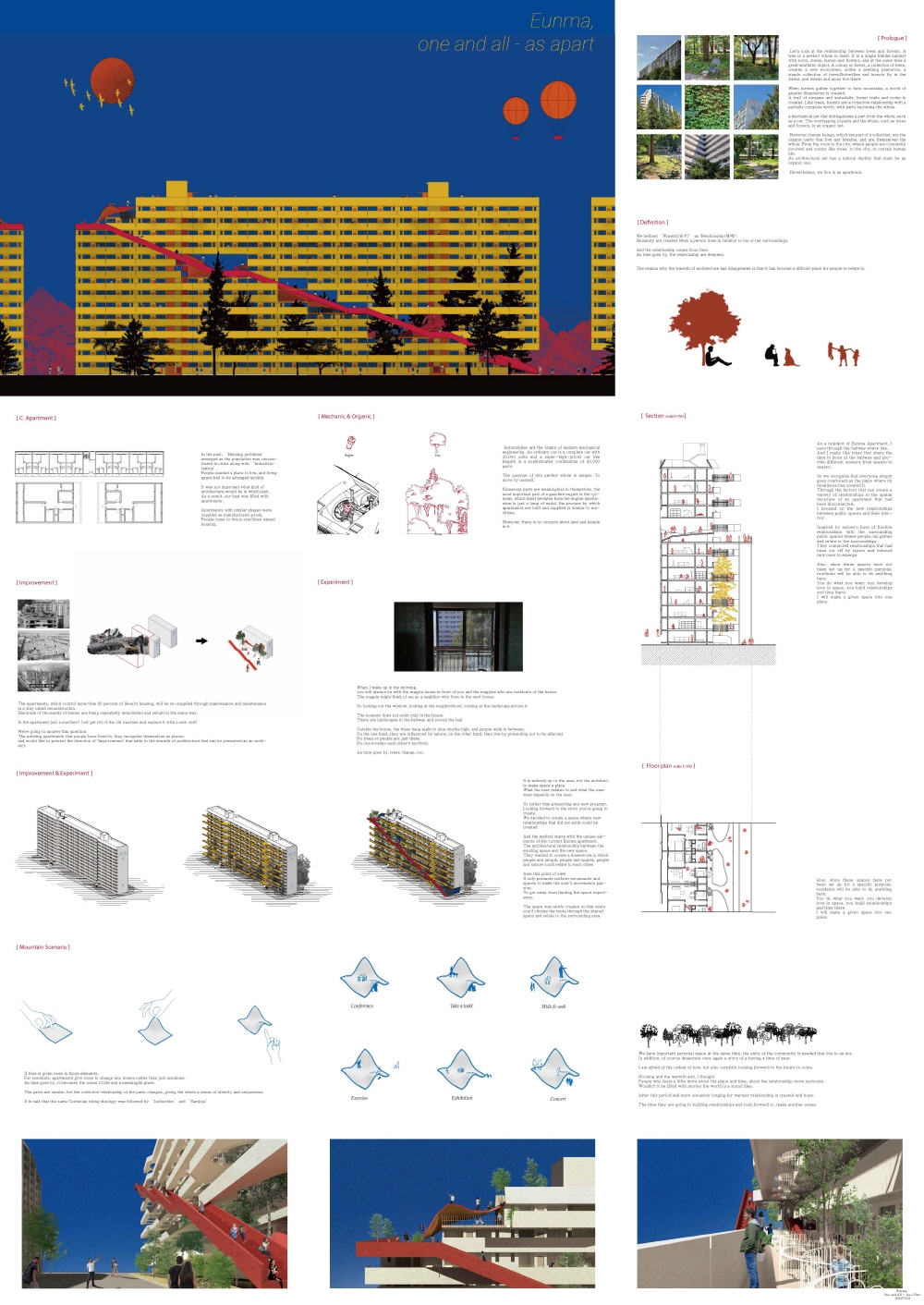 Under the conventional communal housing system, we reflect on our responsibility as an architect and the true meaning of architecture based on the genuine understanding of warmth and humanity.
Under the conventional communal housing system, we reflect on our responsibility as an architect and the true meaning of architecture based on the genuine understanding of warmth and humanity.
We decided to focus on the essence of assembly.
We associate a traditional apartment complex with a set of machines that assembles and operates based on the instructions. It was an efficiency-driven solution that aims to grapple with the housing problem in Korea, makes the building supplier-oriented and monolithic. However, machine-like apartments could never be the one that feeds our soul. Because we expect more from our home than as a means of residing
While redeveloping apartment complexes become trending, we define ‘warmth’ as a ‘relation’ to introduce new tackling strategies for the old apartment complex.
We will witness significant changes if the machine-like apartment marries with social engagement. These changes could boil down to empowering warmth in architecture by transforming public spaces into a social hub that actively involves people.
Eunma Apartment, the classic, shabby-looking apartment complex that denounced as hampering neighboring views for many years, is now morphing into minted experiences that offer intimate connections between residents.
Amid rapid changing times, we wish our definition of warmth and relations could contribute to molding the upcoming future.
Jury’s comment
The work did not negatively view the residential form of a universal apartment in Korea. Instead, the presentation, which expresses the humanity inherent in the life of the place through videos, was warm and persuasive. In particular, it was notable that the residents found areas where they had to think and solve realistically and suggested solutions from the perspective of architects.
SPECIAL PRIZE
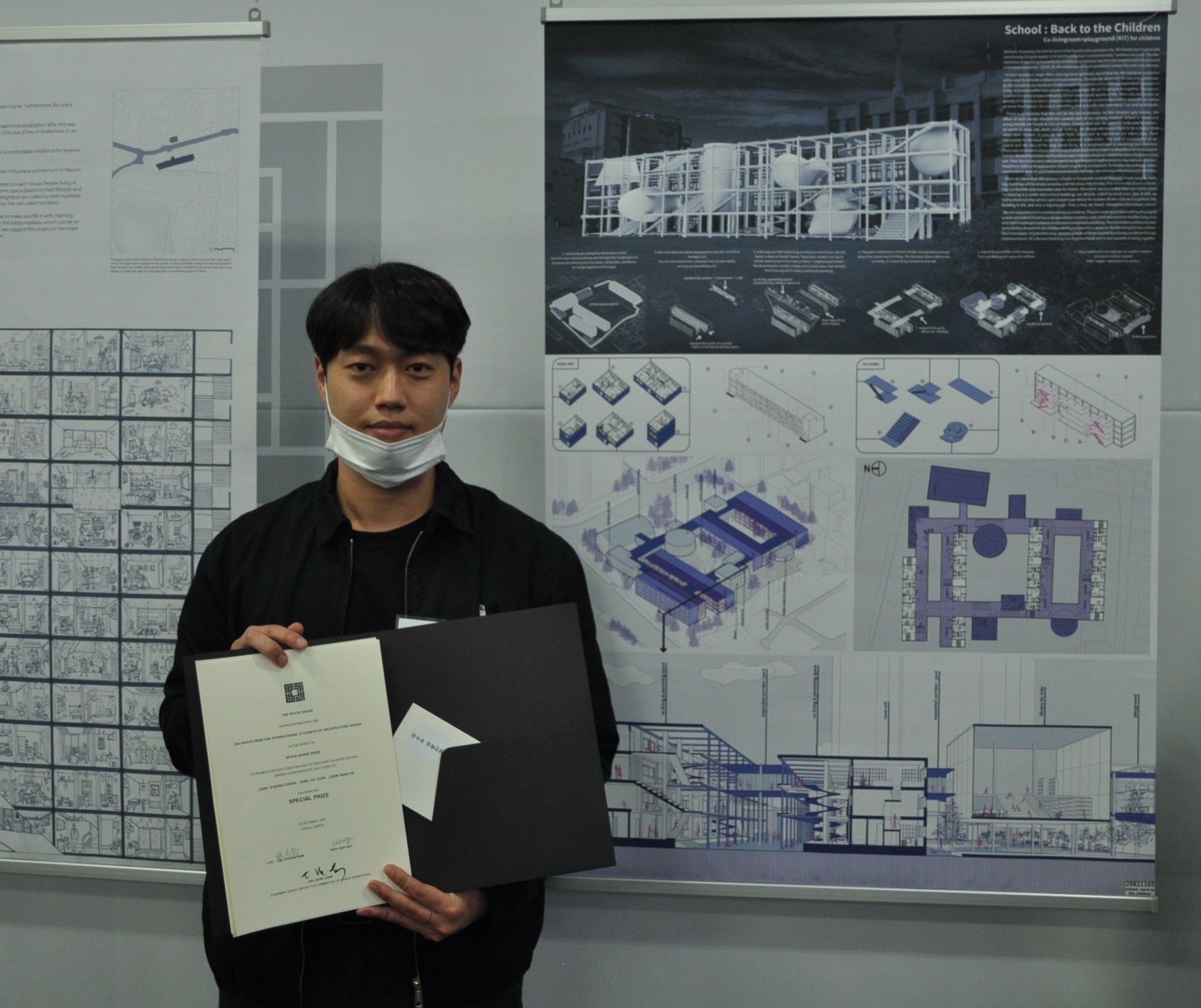
JANG, GYEONG CHEON
PARK, HA YOON
LEEM, SANG HA
Hongik University
School: Back to the children
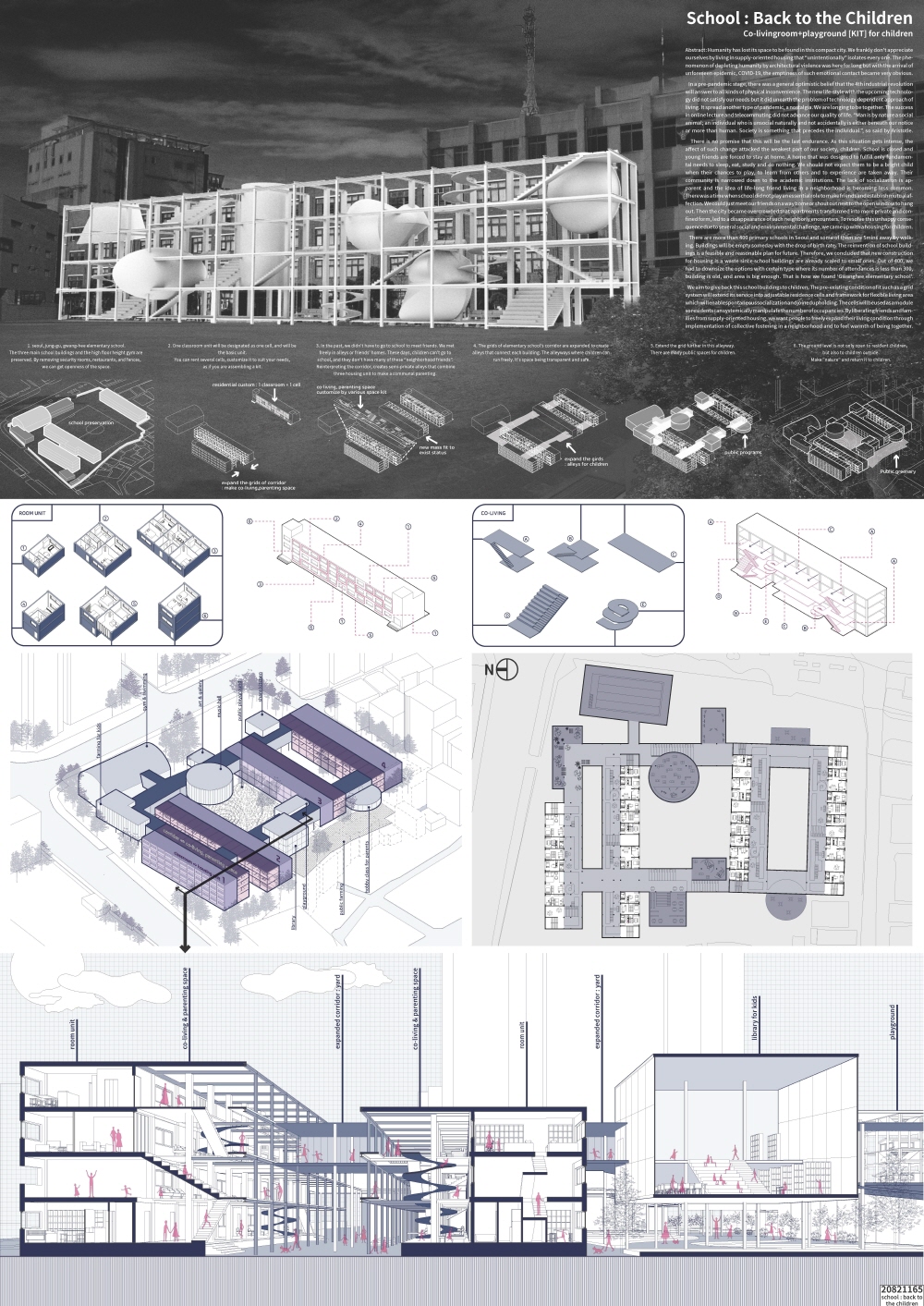 Co-living+parenting house for children
Co-living+parenting house for children
Humanity has lost its space to be found in this compact city. We frankly don’t appreciate ourselves by living in supply-oriented housing that “unintentionally” isolates every one. Also, the arrival of unforeseen epidemic, COVID-19, the emptiness of such emotional contact became very obvious. In a pre-pandemic stage, there was a general optimistic belief that the 4th industrial revolution will answer to all kinds of physical inconvenience. The new life-style with the upcoming technology did not satisfy our needs but it did unearth the problem of technology dependent approach of living. It spread another type of pandemic, a nostalgia. We are longing to be together. “Man is by nature a social animal.”, so said by Aristotle.
As this situation gets intense, the affect of such change attacked the weakest part of our society, children. School is closed and young friends are forced to stay at home. We should not expect apartment to be a bright child when their chances to play, to learn from others and to experience are taken away. Their community is narrowed down to the academic institutions. The lack of socialization is apparent and the idea of life-long friend living in a neighborhood is becoming less common. There was a time when school did not play an essential role to make friends and establish mutual affection. We could just meet our friends on a way home or shout out next to the open window to hang out. Then the city became overcrowded that apartments transformed into more private and confined form, led to a disappearance of such neighborly encounters. To resolve this unhappy consequence due to several social and environmental challenge, we came up with a housing for children.
There are more than 400 primary schools in Seoul. But buildings will be empty someday with the drop of birth rate. The reinvention of school buildings is a feasible and reasonable plan for future. Therefore, we concluded that new construction for housing is a waste since school buildings are already scaled to small ones. Out of 400, we had to downsize the options with certain type where its number of attendances is less than 300, building is old, and area is big enough. That is how we found ‘Gwanghee elementary school’.
We aim to give back this school buildings to children. The pre-existing condition of it such as a grid system will extend its service into adjustable residence cells and framework for flexible living area which will enable spontaneous socialization and joined upholding. The cells will be used as a module so residents can systemically manipulate the number of occupancies. By liberating friends and families from supply-oriented housing, we want people to freely expand their living condition through implementation of collective fostering in a neighborhood and to feel warmth of being together.
Jury’s comment
The novelty of the idea of utilizing closed school space stands out. It was an ideal setting, but it was also a possible alternative in the near future. I took a good look at the suggestion of a new way of interacting. The view of a growing society through the medium of children was well suited to the theme of humanity.
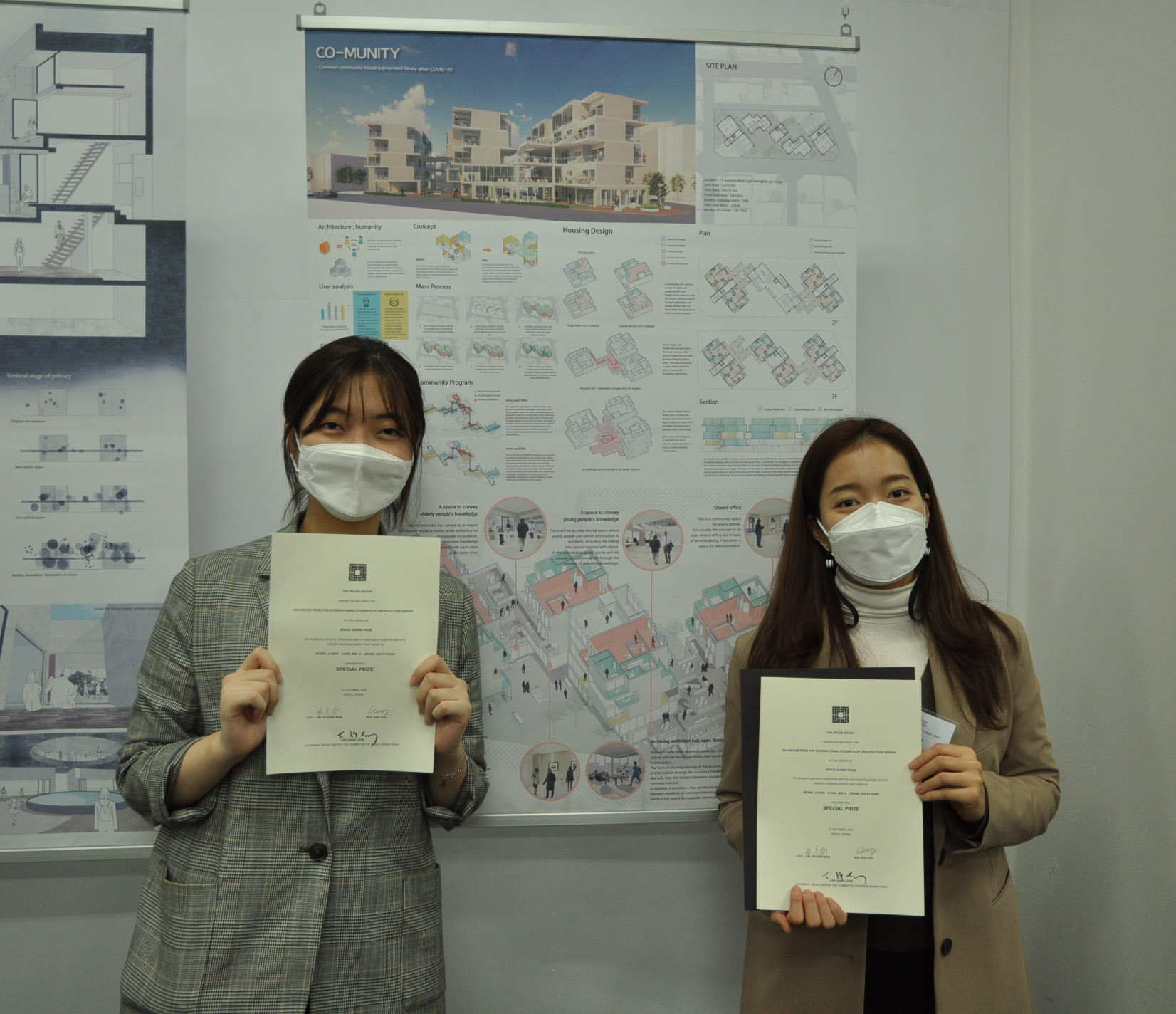
JEONG, JI WON
KANG, MIN JI
JEONG, EUI RYEONG
Seoul National University of Science and Technology
Co-munity
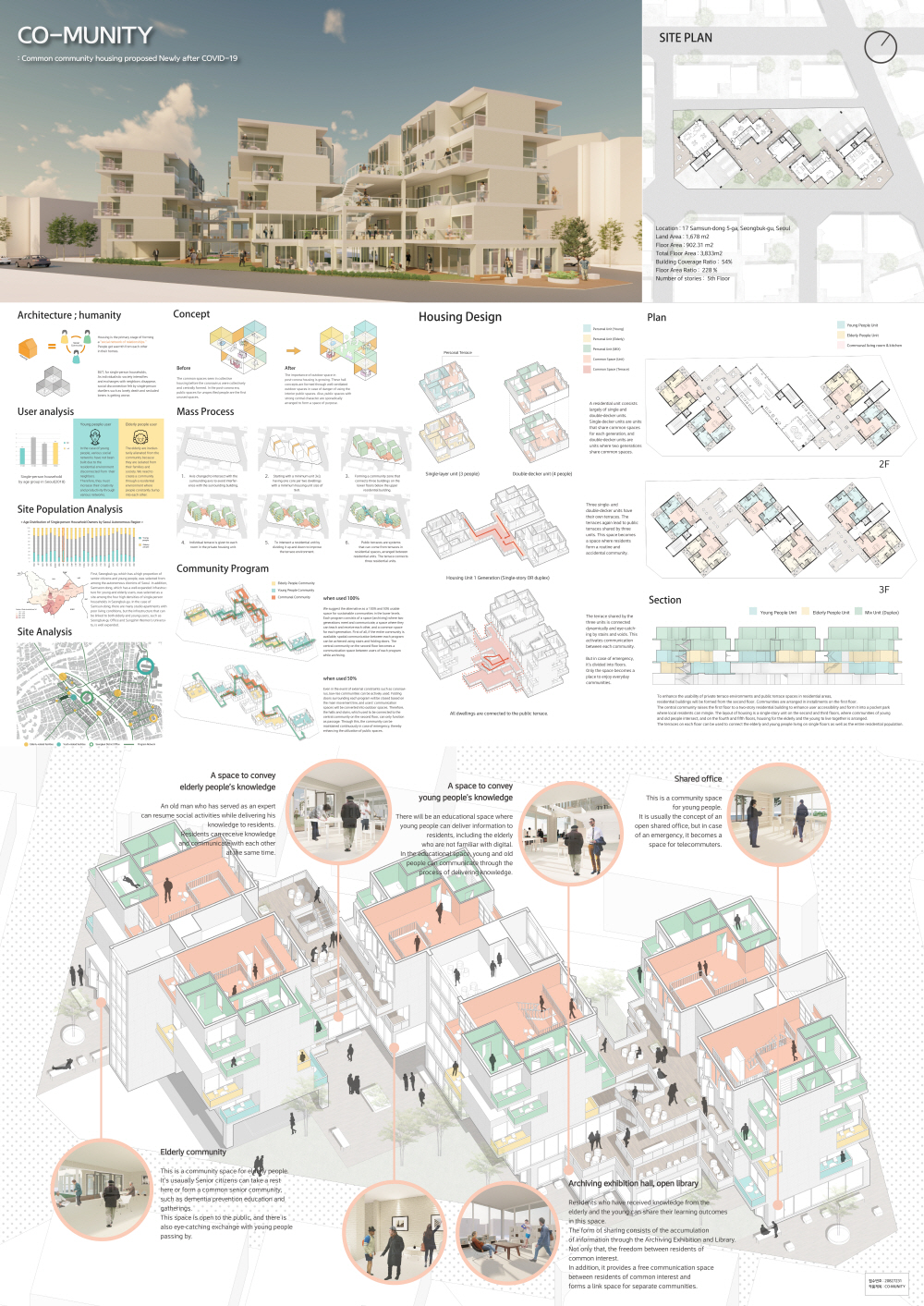 The warmth in residencesbegins with social interaction between people. Multifamilyhousingcomplex, in particular, is a residential space where people of various types interact and live together, reminiscent of the miniature village.
The warmth in residencesbegins with social interaction between people. Multifamilyhousingcomplex, in particular, is a residential space where people of various types interact and live together, reminiscent of the miniature village.
However, most residents of the complex often live withouthaving a conversation orknowing each other's faces. Losing communities isparticularly prominent in single-person dwellings.The form of a "one-room" where single-person households usually live is a space that is not suitable for individuals to live in, and a disconnected space where communities with others are not well established.Therefore, those who mainly engaged in social exchanges with others in the outer space of their residence lost the opportunity for face-to-face communication with the advent of the post-corona era.
'CO-MUNITY' started with the view that in the post-Corona era, sustainable minimum residential communities should be provided. The type of community previously used in Multifamilyhousingcomplexconsists mainly of a hierarchical form of 'entry-hole-core-room space' composed around the hall.n this composed space, frequent circulations and face-to-face meetings from the main entrance to the room occur, which enables the formation of a natural community in everyday life. This, on the other hand, is also a reason why community space is limited in times of crisis such as Corona.Therefore, we propose a 'CO-MUNITY' in which minimal communities can persist in the Corona era.We hope that members of young people and elderly single-person households who are greatly affected by the loss of face-to-face communities can be consolded by 'CO-MUNITY', maintaining a lasting community in the post-Corona era.
Jury’s comment
The work proposed a collective housing program that can be shared by young and old people who are prone to alienation from society. As a single-person household, the plan is to carefully consider various shared spaces. We highly appreciate the fact that we have considered realistic plans and ways to compensate for the shortcomings of existing collective housing.
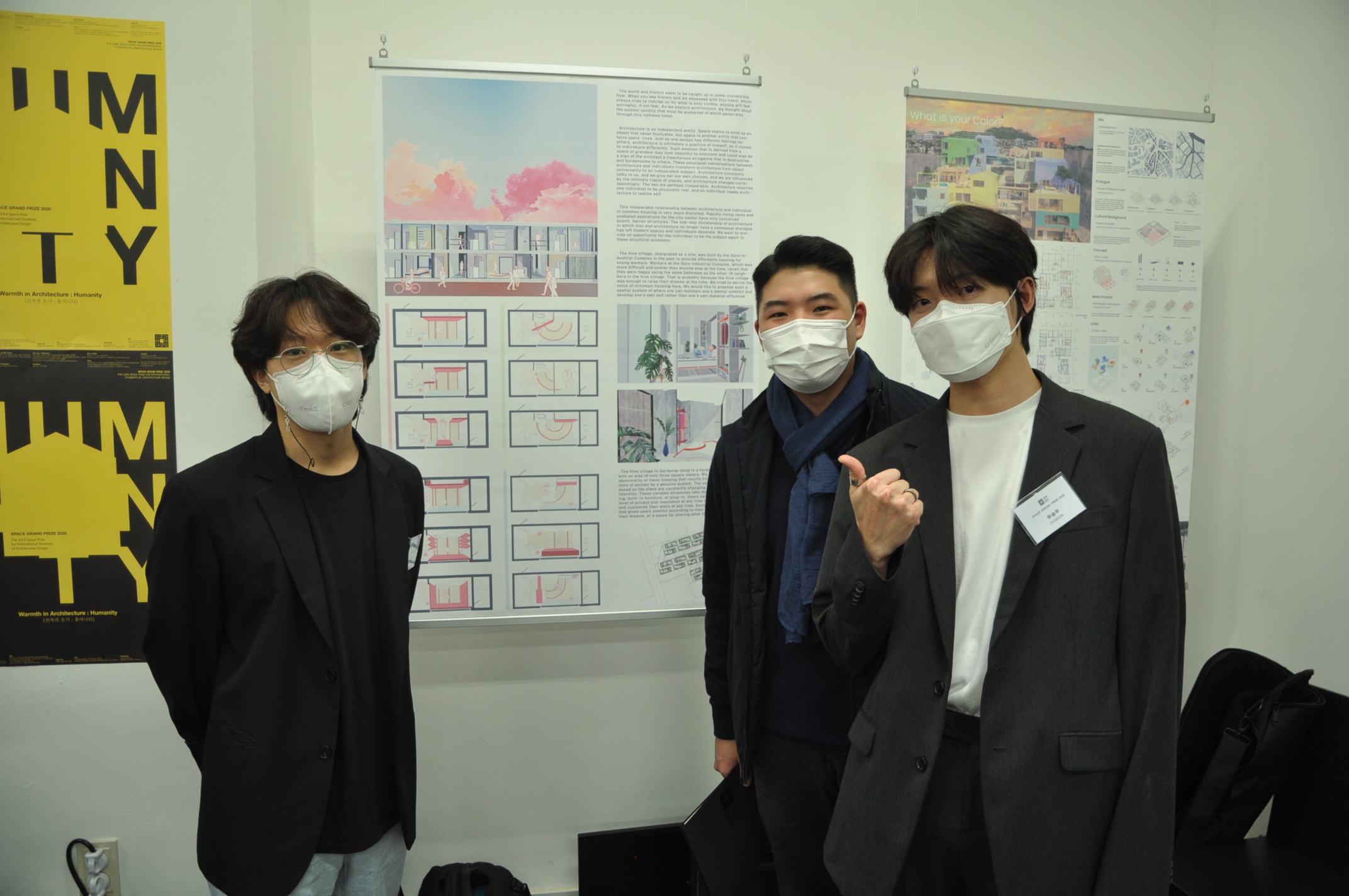
CHOI, MIN JOON
WOO, SEUNG WOO
YOO, JUNG MIN
Kookmin University
DOMAIN
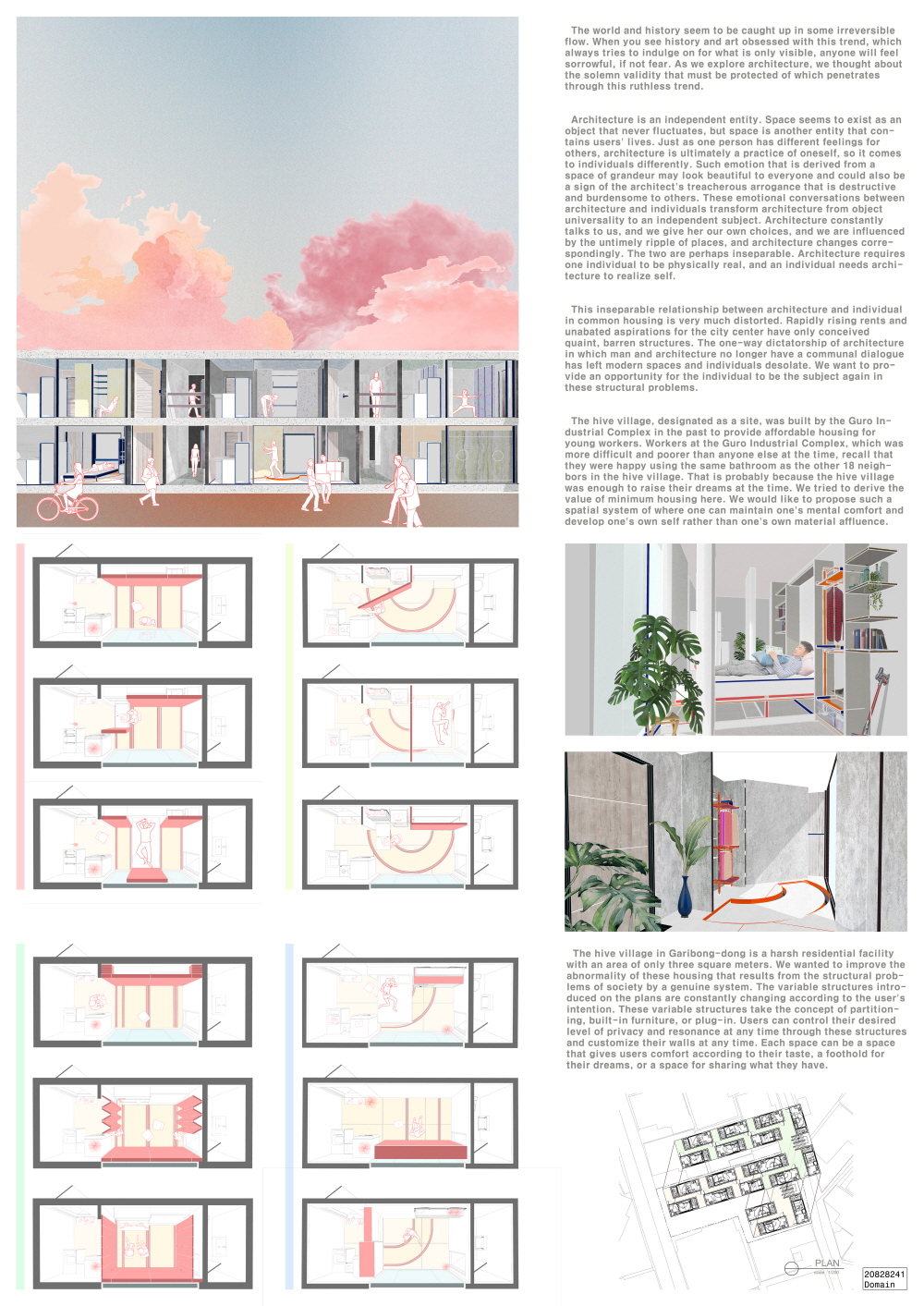 The world and history seem to be caught up in some irreversible flow. When you see history and art obsessed with this trend, which always tries to indulge on for what is only visible, anyone will feel sorrowful, if not fear. As we explore architecture, we thought about the solemn validity that must be protected of which penetrates through this ruthless trend
The world and history seem to be caught up in some irreversible flow. When you see history and art obsessed with this trend, which always tries to indulge on for what is only visible, anyone will feel sorrowful, if not fear. As we explore architecture, we thought about the solemn validity that must be protected of which penetrates through this ruthless trend
Architecture is an independent entity. Space seems to exist as an object that never fluctuates, but space is another entity that contains users' lives. Just as one person has different feelings for others, architecture is ultimately a practice of oneself, so it comes to individuals differently. Such emotion that is derived from a space of grandeur may look beautiful to everyone and could also be a sign of the architect's treacherous arrogance that is destructive and burdensome to others. These emotional conversations between architecture and individuals transform architecture from object universality to an independent subject. Architecture constantly talks to us, and we give her our own choices, and we are influenced by the untimely ripple of places, and architecture changes correspondingly. The two are perhaps inseparable. Architecture requires one individual to be physically real, and an individual needs architecture to realize self. This inseparable relationship between architecture and individual in common housing is very much distorted. Rapidly rising rents and unabated aspirations for the city center have only conceived quaint, barren structures. The one-way dictatorship of architecture in which man and architecture no longer have a communal dialogue has left modern spaces and individuals desolate. We want to provide an opportunity for the individual to be the subject again in these structural problems.
The hive village, designated as a site, was built by the Guro Industrial Complex in the past to provide affordable housing for young workers. Workers at the Guro Industrial Complex, which was more difficult and poorer than anyone else at the time, recall that they were happy using the same bathroom as the other 18 neighbors in the hive village. That is probably because the hive village was enough to raise their dreams at the time. We tried to derive the value of minimum housing here. We would like to propose such a spatial system of where one can maintain one's mental comfort and develop one's own self rather than one's own material affluence.
Jury’s comment
The plan is to improve the existing buildings in the dosshouse village. It was notable that the human scale was considered as a plan that took into account the proper area, storage space, and improvement of lighting for human life. The delicate approach to each individual's existence was outstanding.
SELECTED WORKS
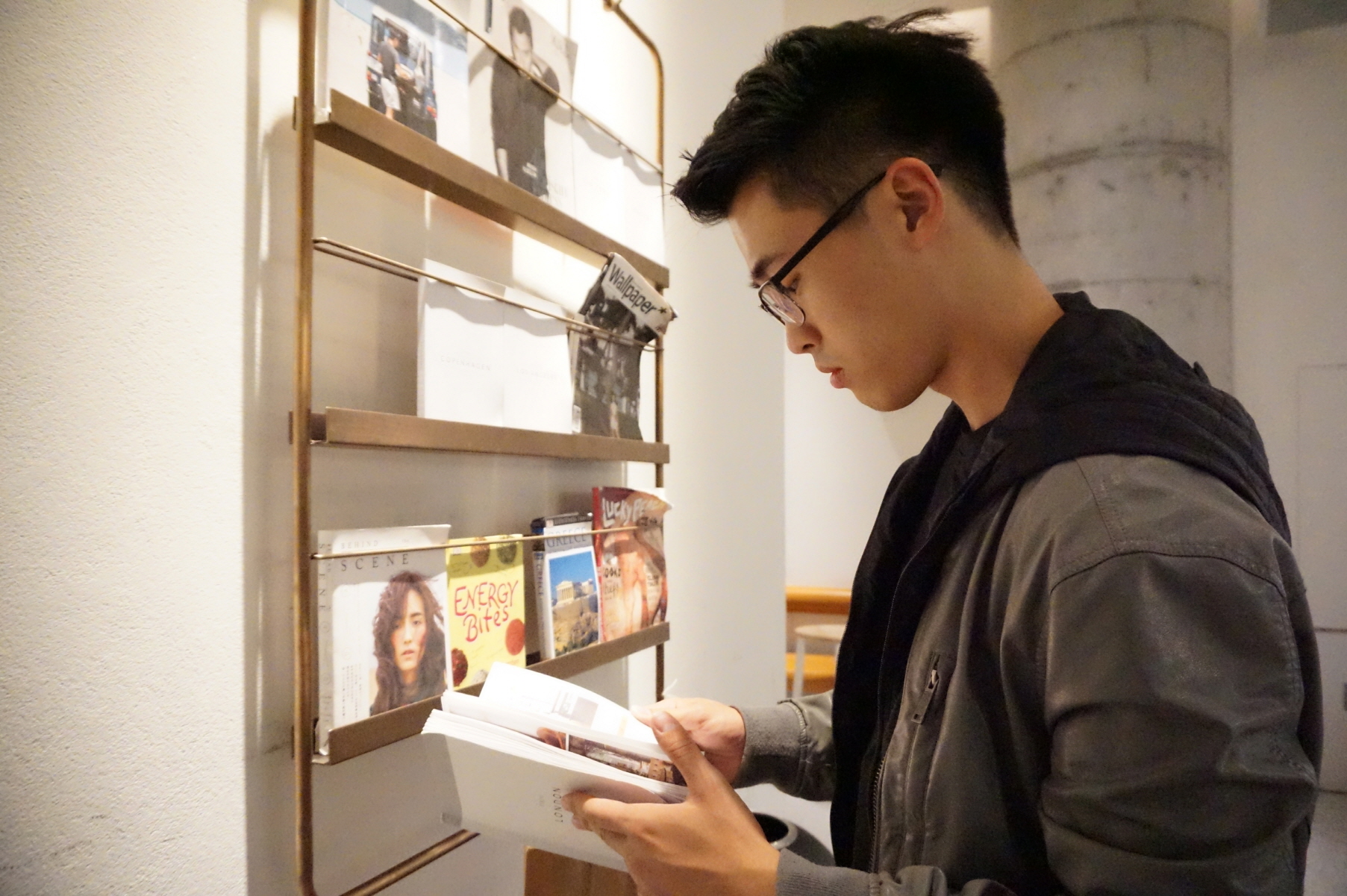
BINGHAO YAO
Soochow University
Habitat- Everyone's private garden
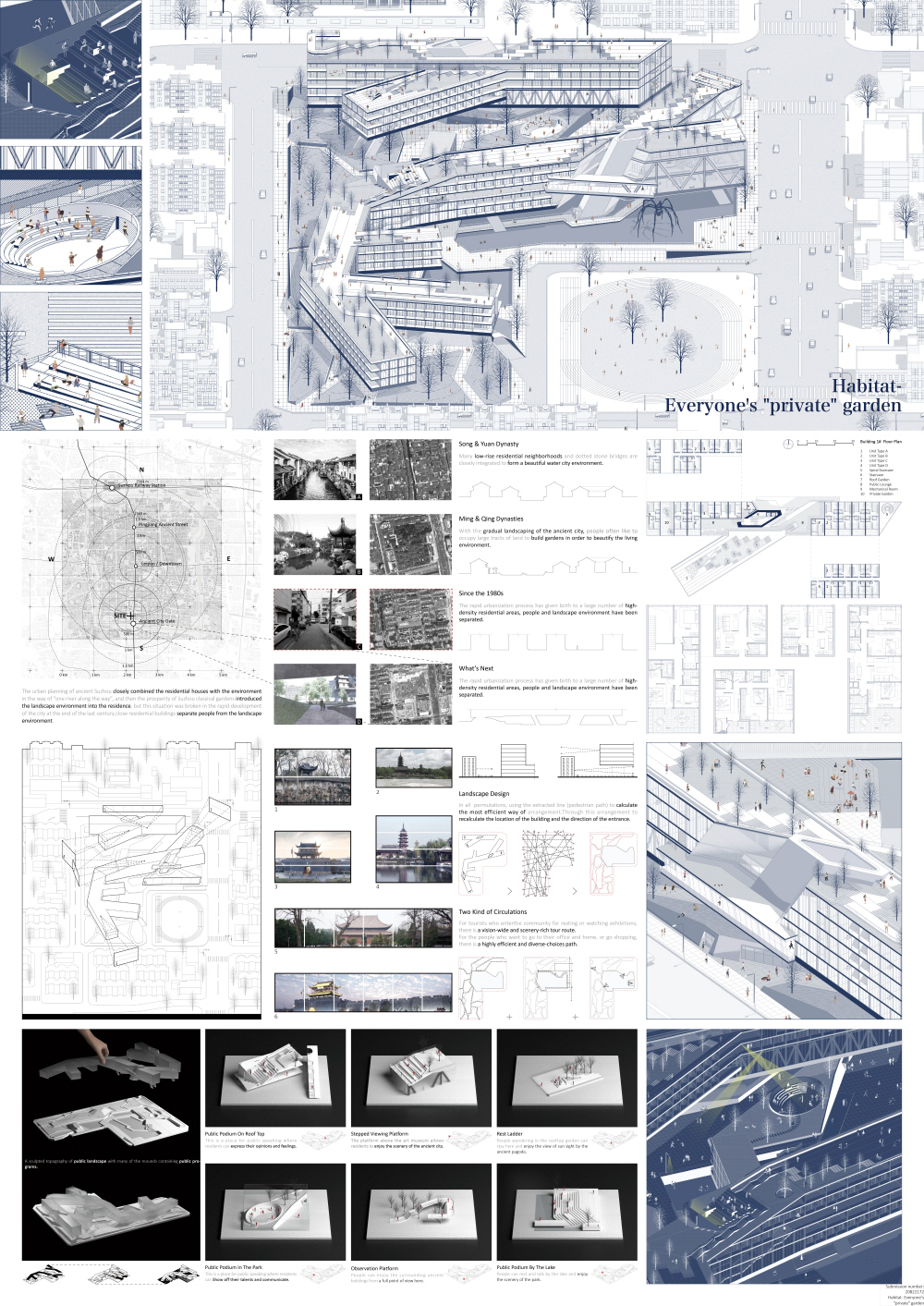
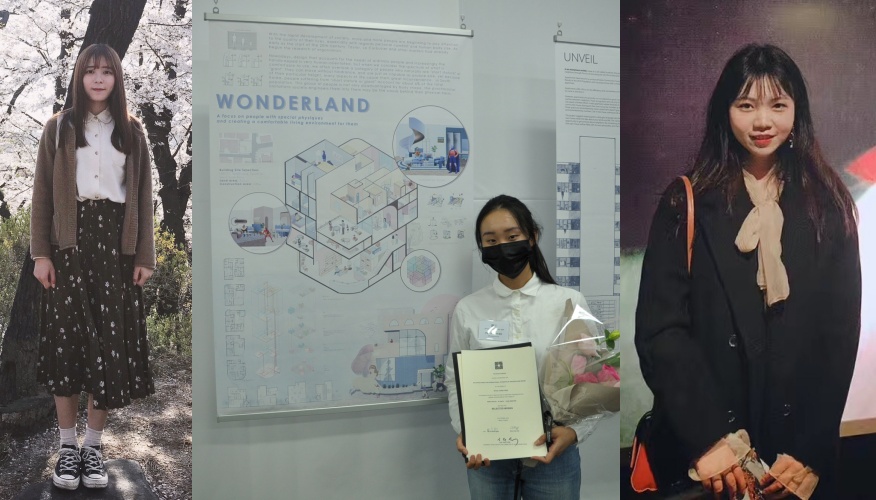
PENG XINYAO
QI JINGYI
YANG WENTING
Kyung Hee University
Wonderland
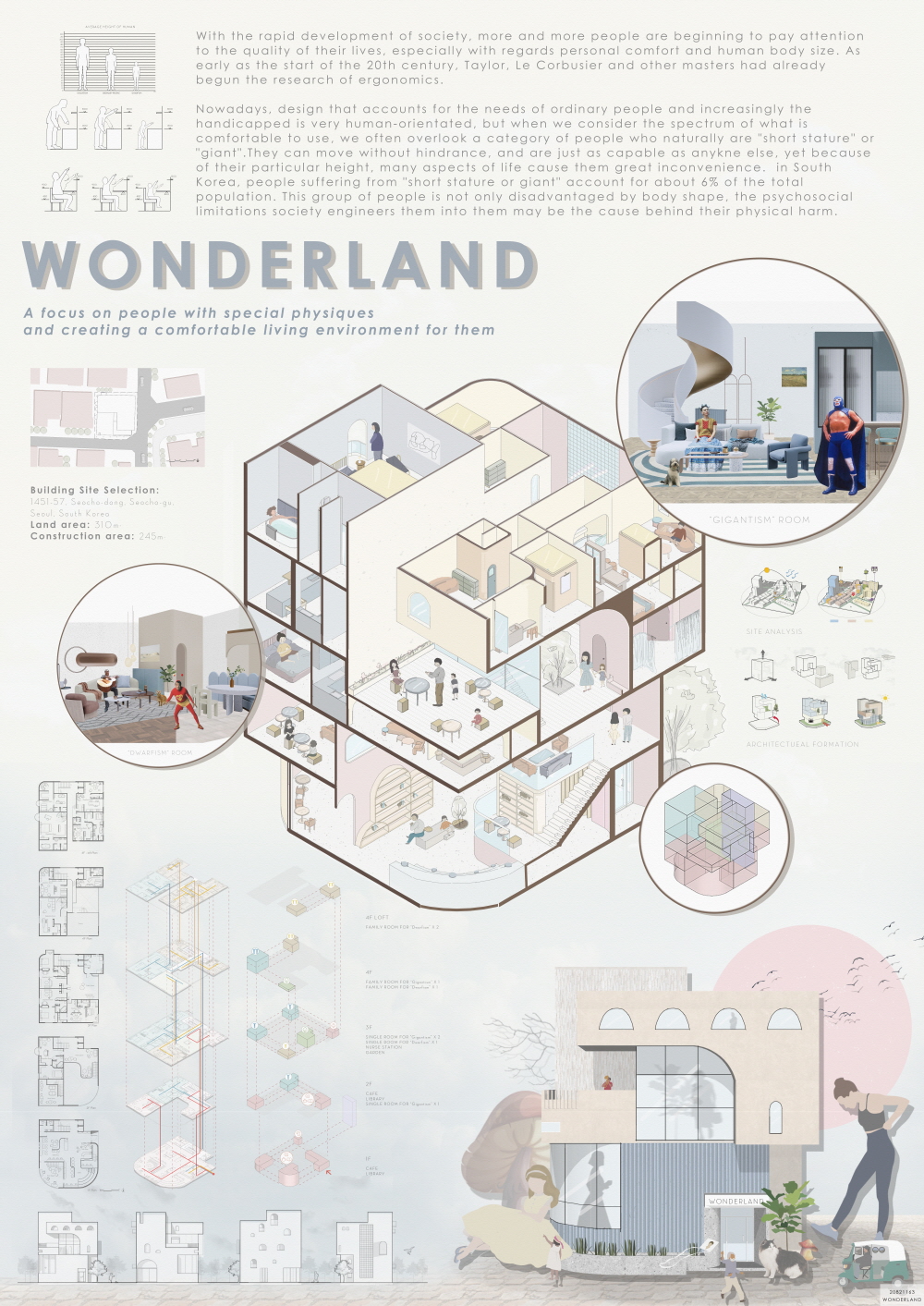
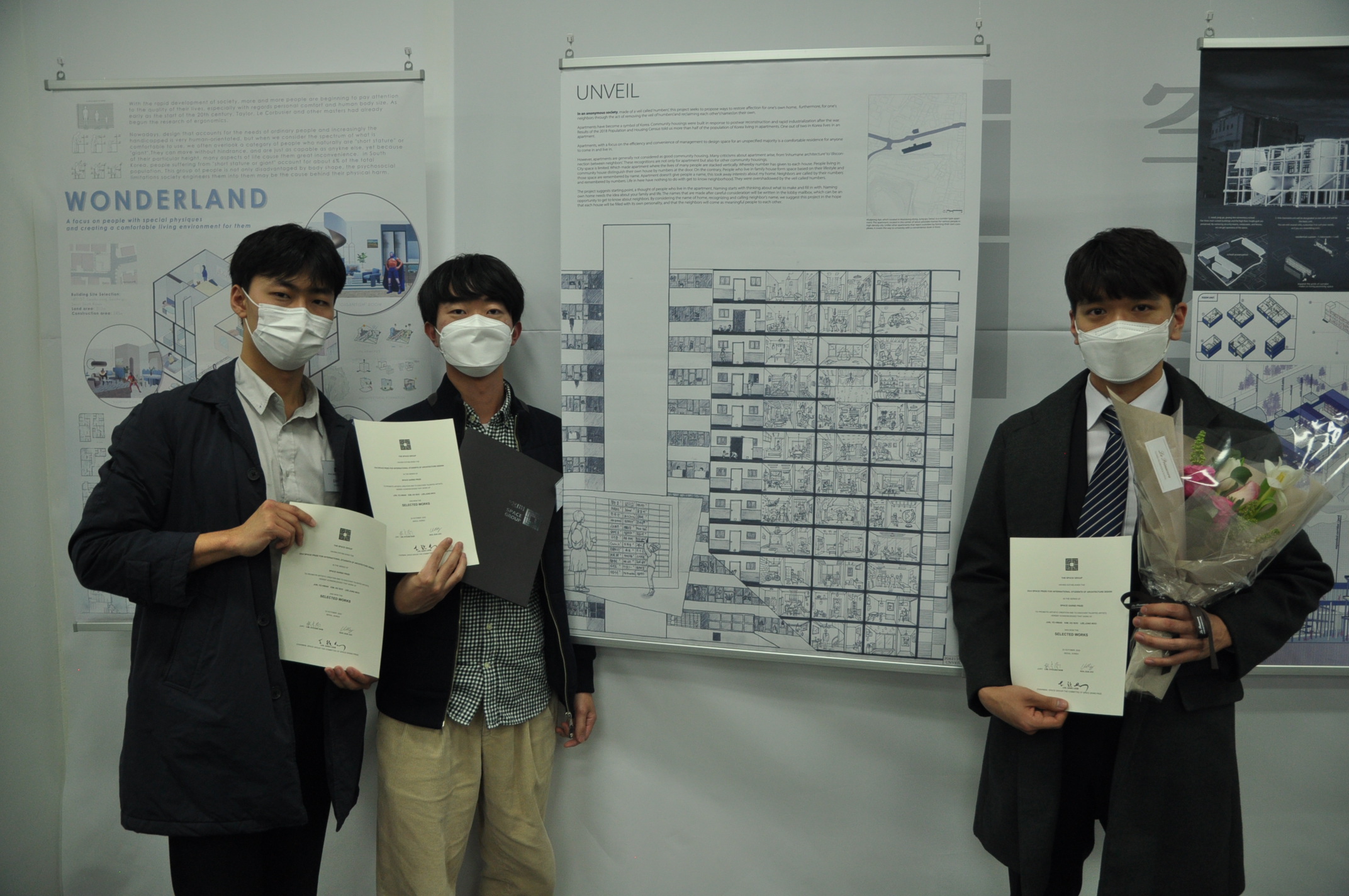
JUN, YO HWAN
KIM, HO SOO
LEE, JUNG WOO
Dongguk University
Unveil
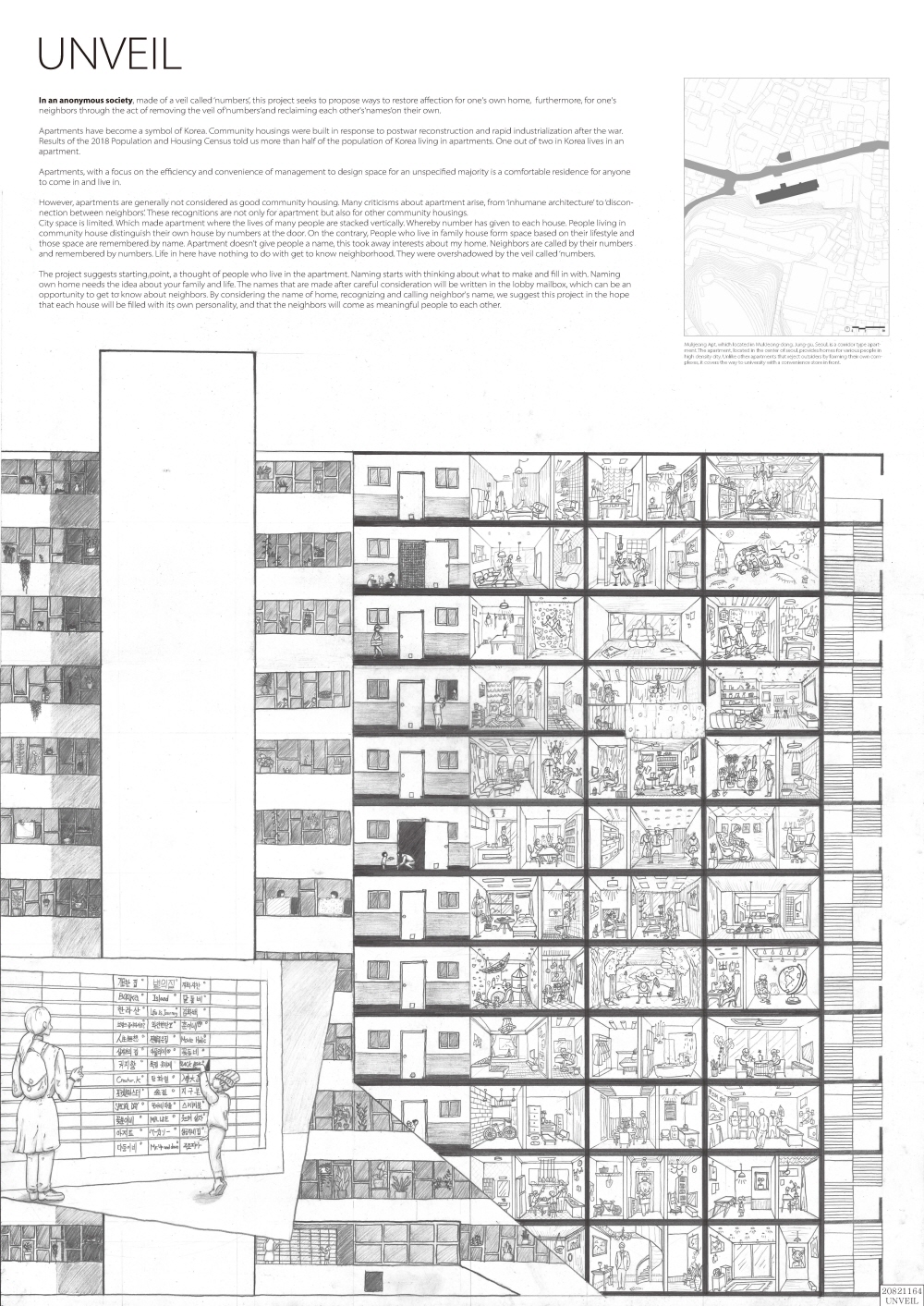
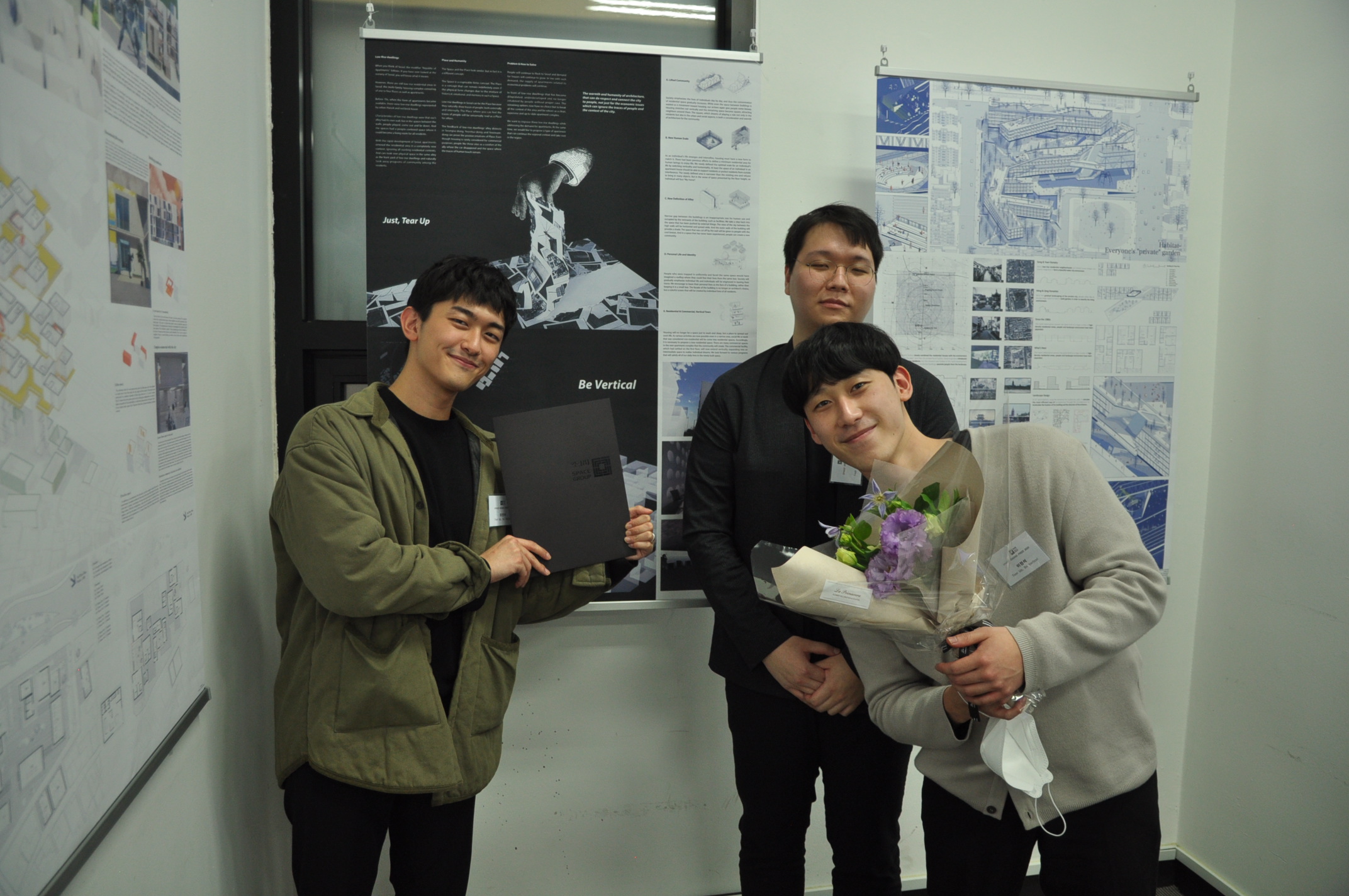
MA, YEONG BEOM
LEE, JEONG SEOK
CHO, MIN SU
Hanyang University
Tear Up, Be Vertical
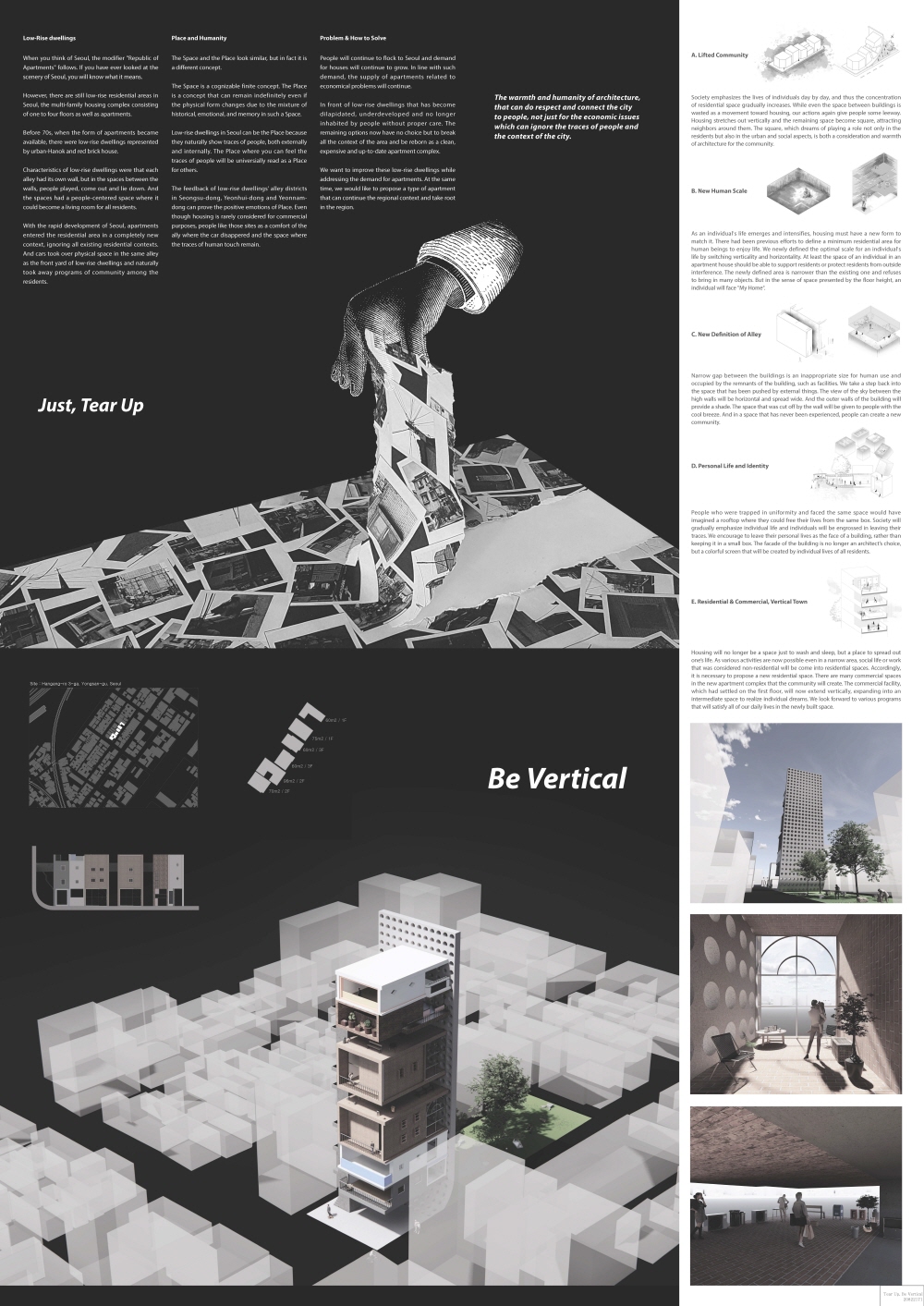
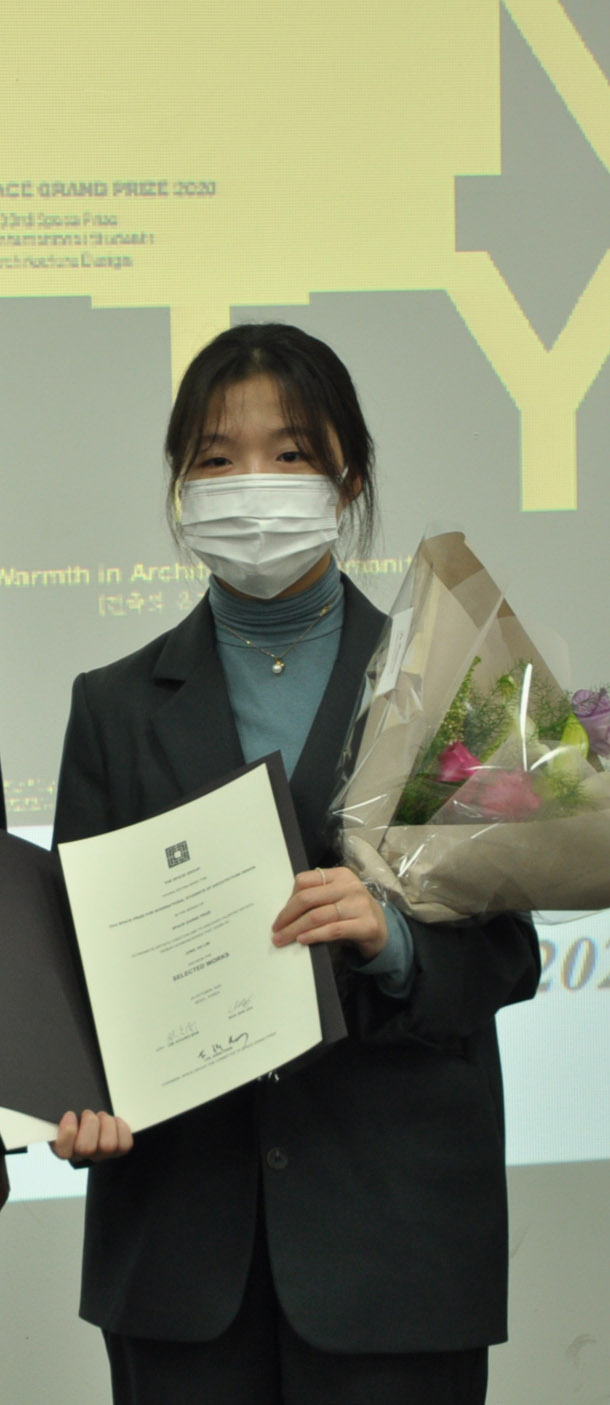
JUNG, HA LIM
Chung-Ang University
What is your color
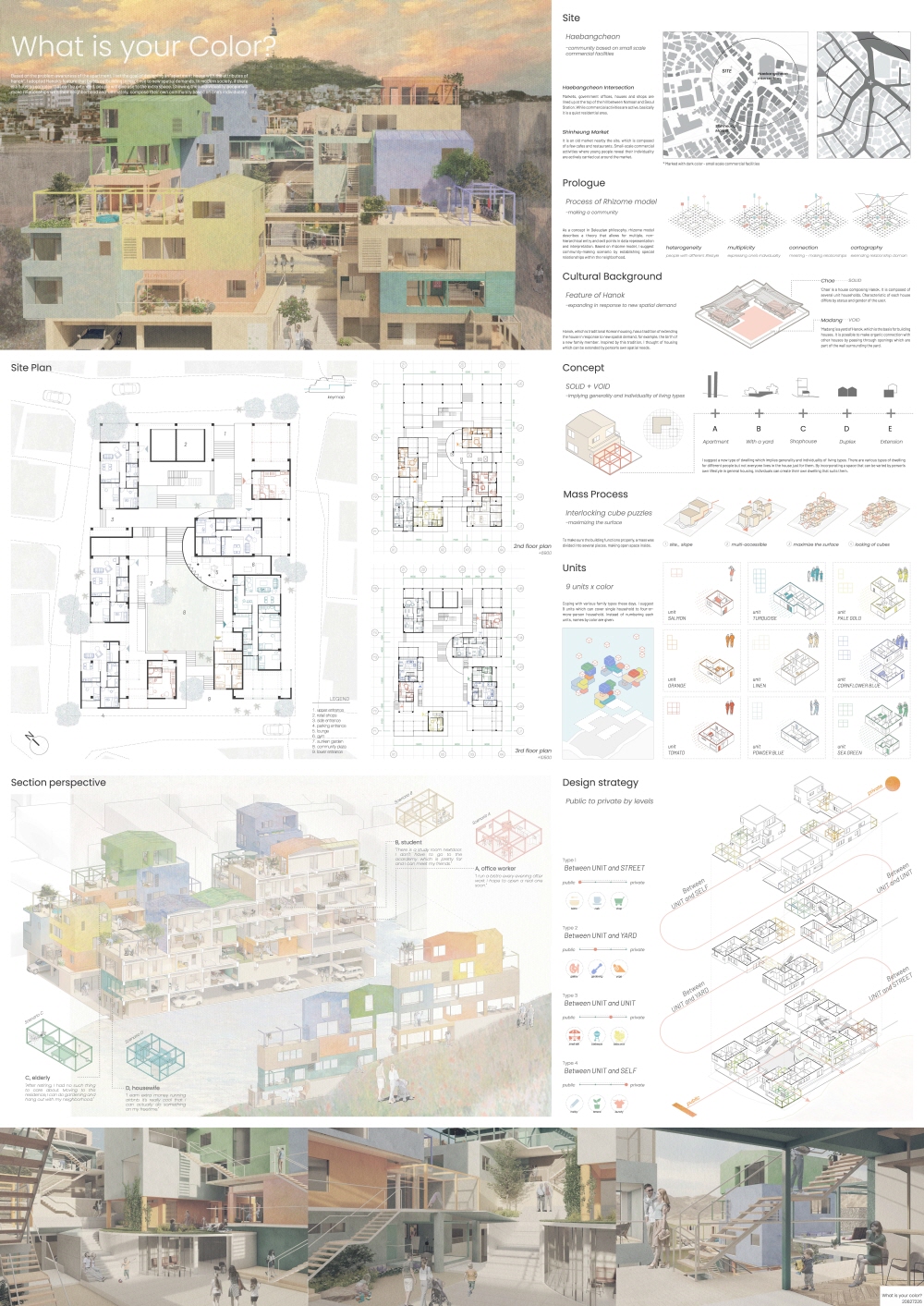
HONORABLE MENTION
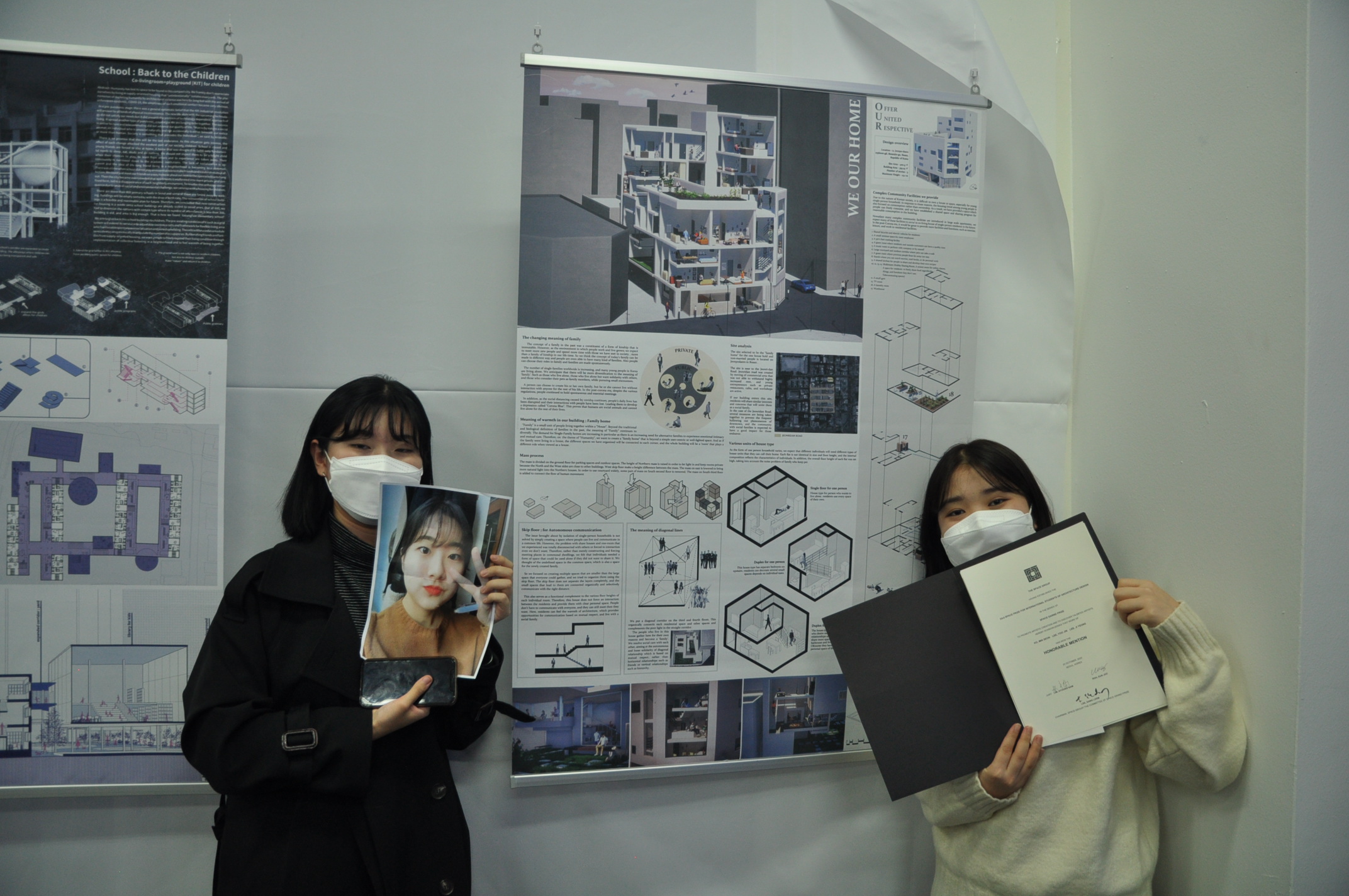
KO, MIN SEON
LEE, YOO JIN
LEE, JI YEONG
Pusan National University
We Our Home
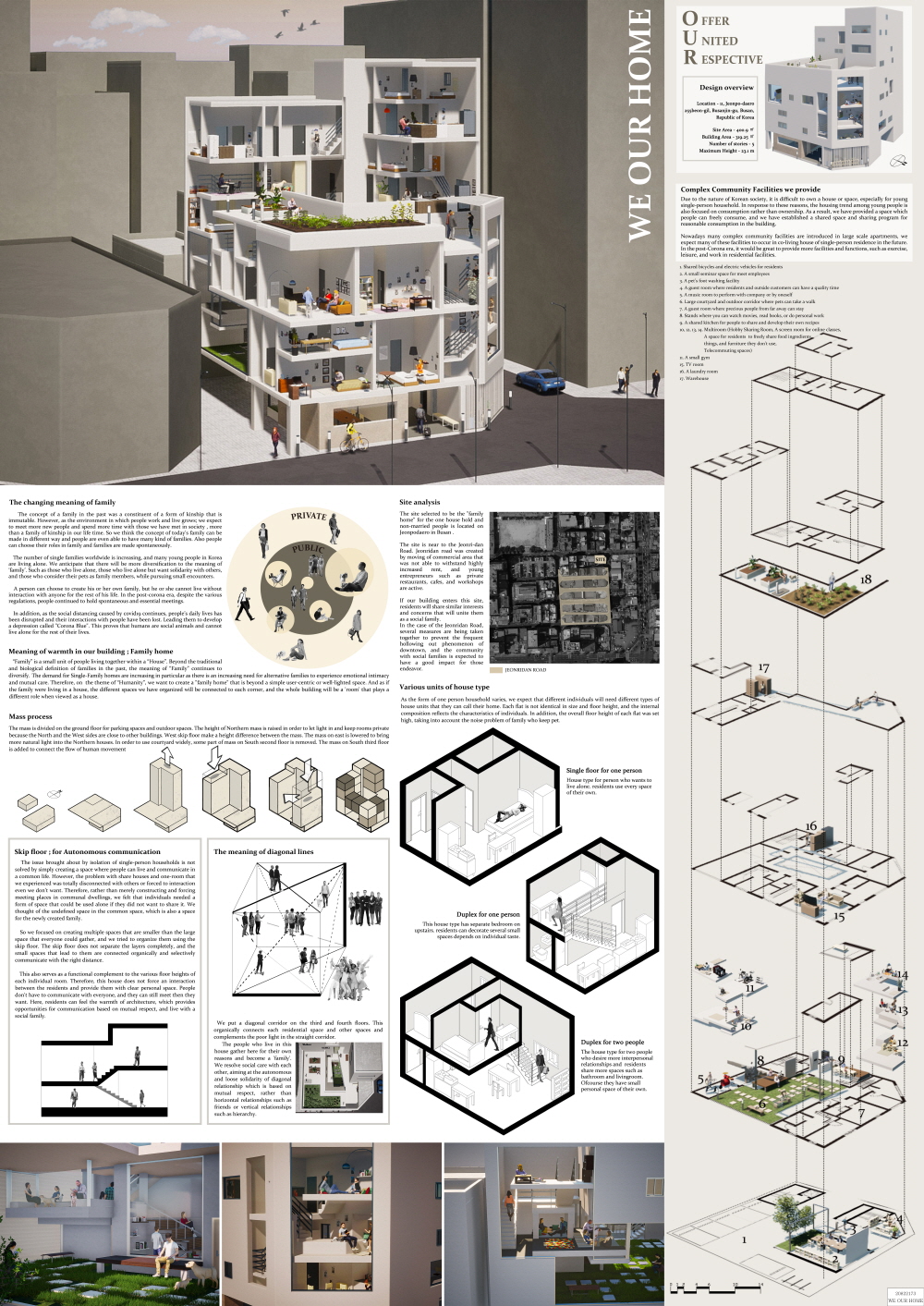
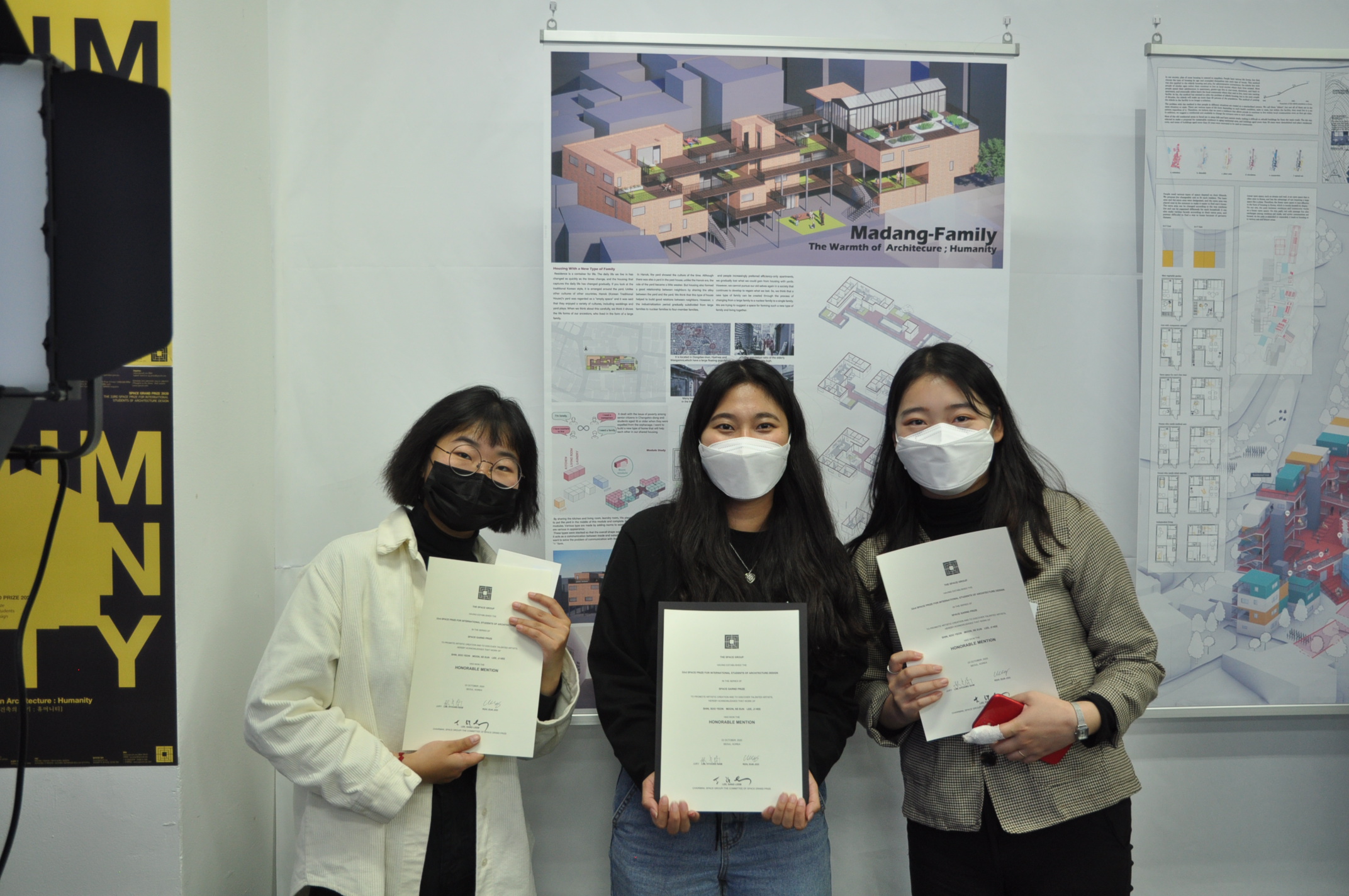
SHIN, SOO YEON
MOON, SE EUN
LEE, JI HEE
Soongsil University
Madang Family
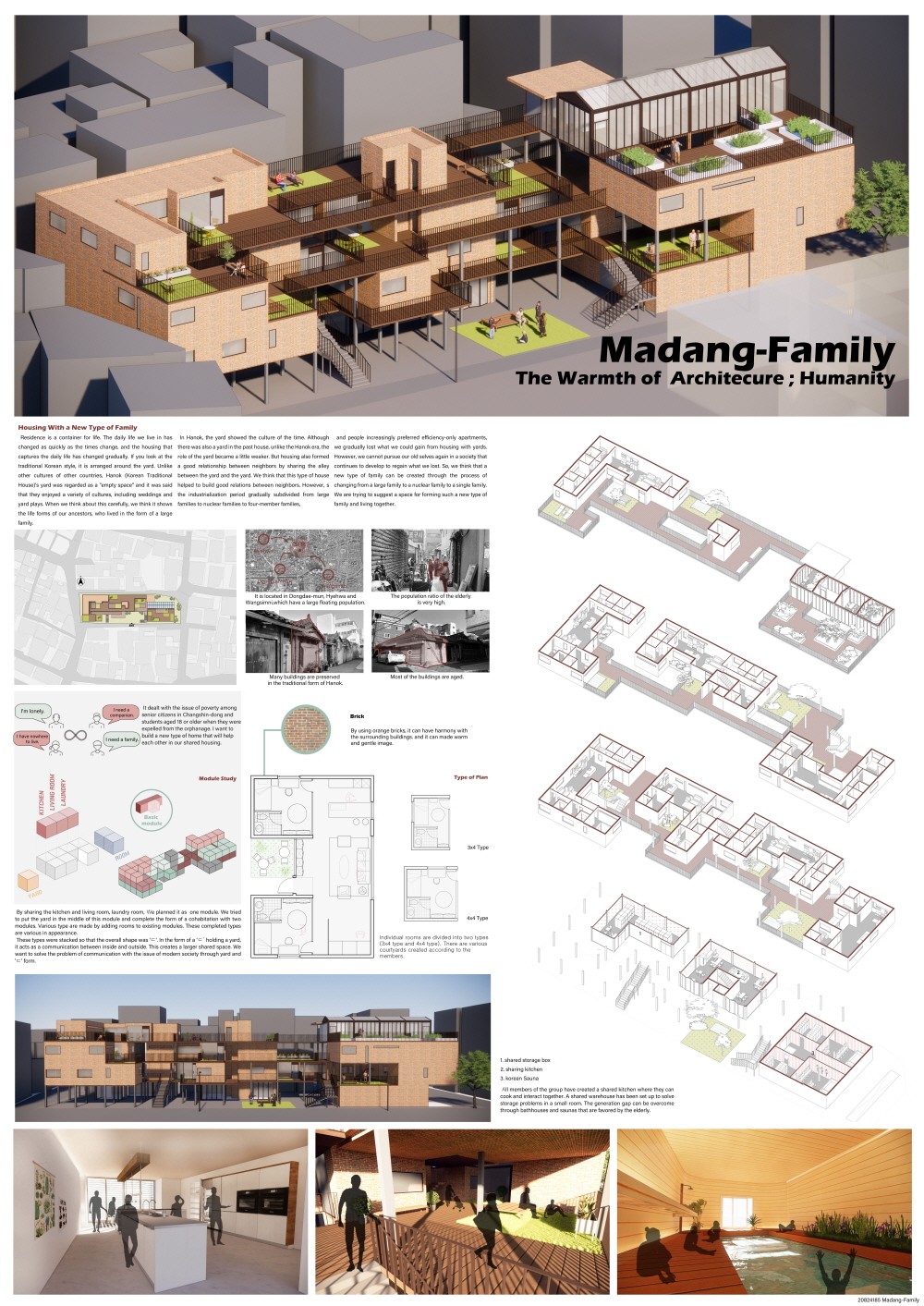
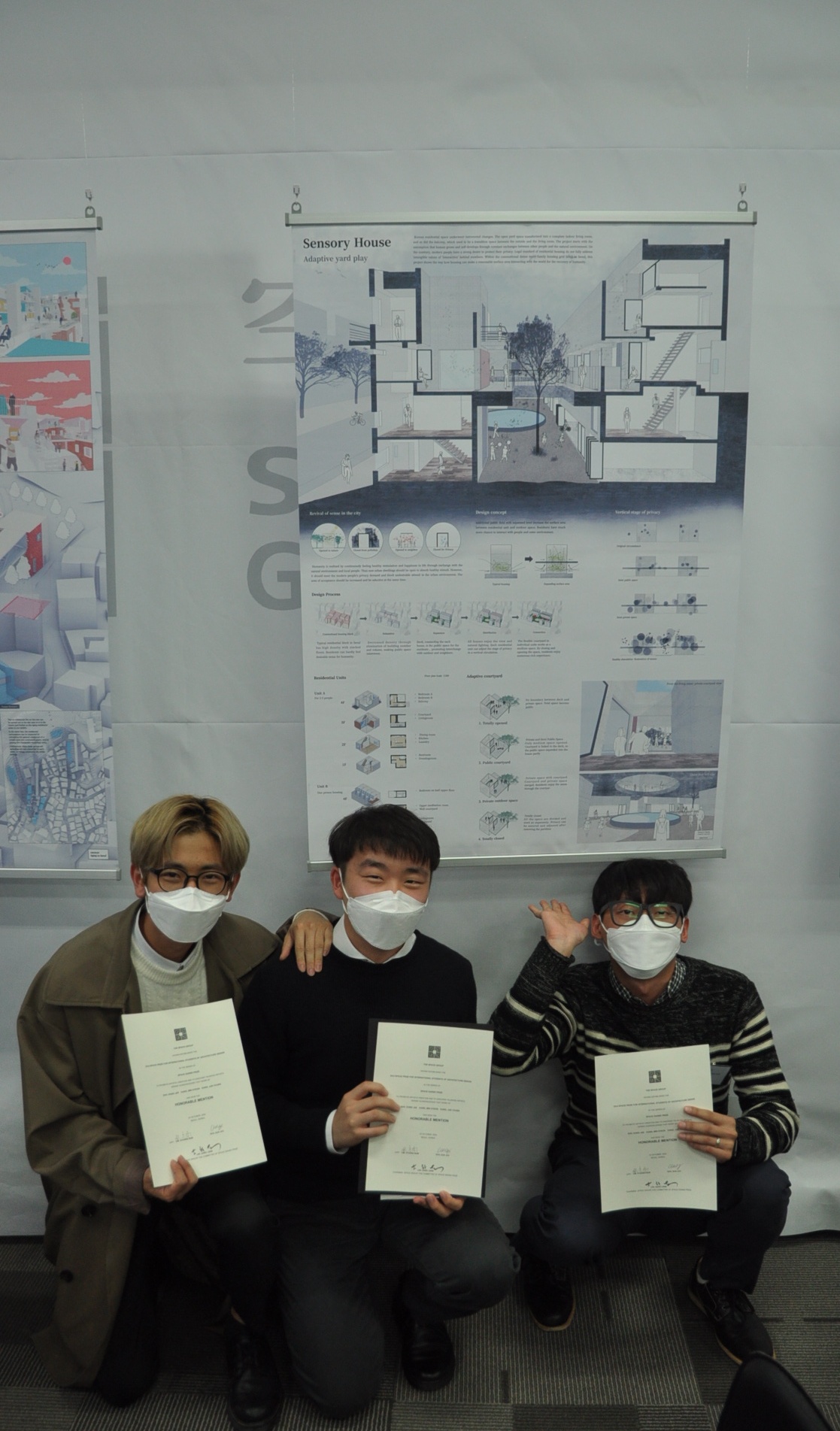
SUH, DONG JAE
KANG, MIN HYEON
KANG, JUN YOUNG
Korea University
Sensory House
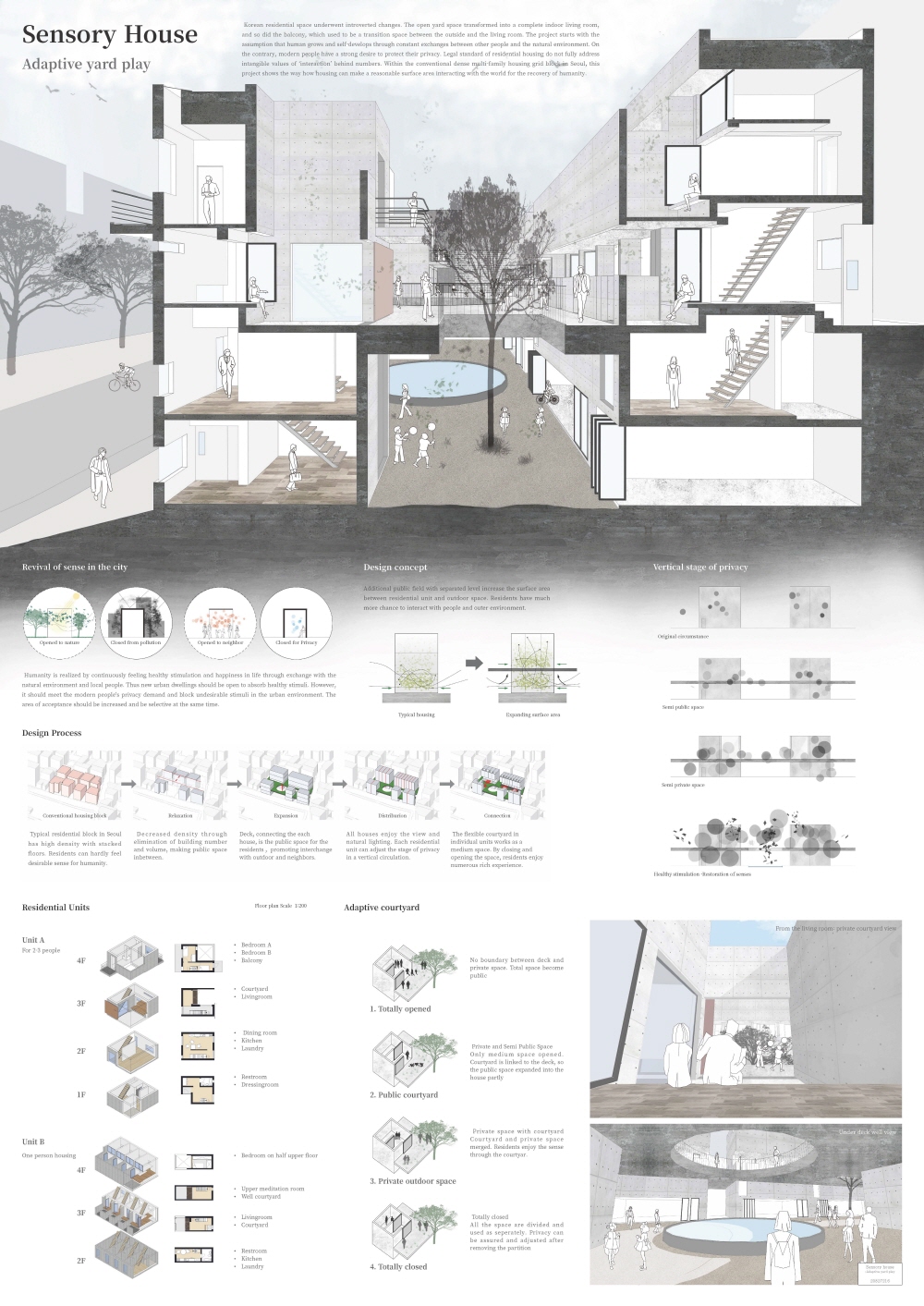
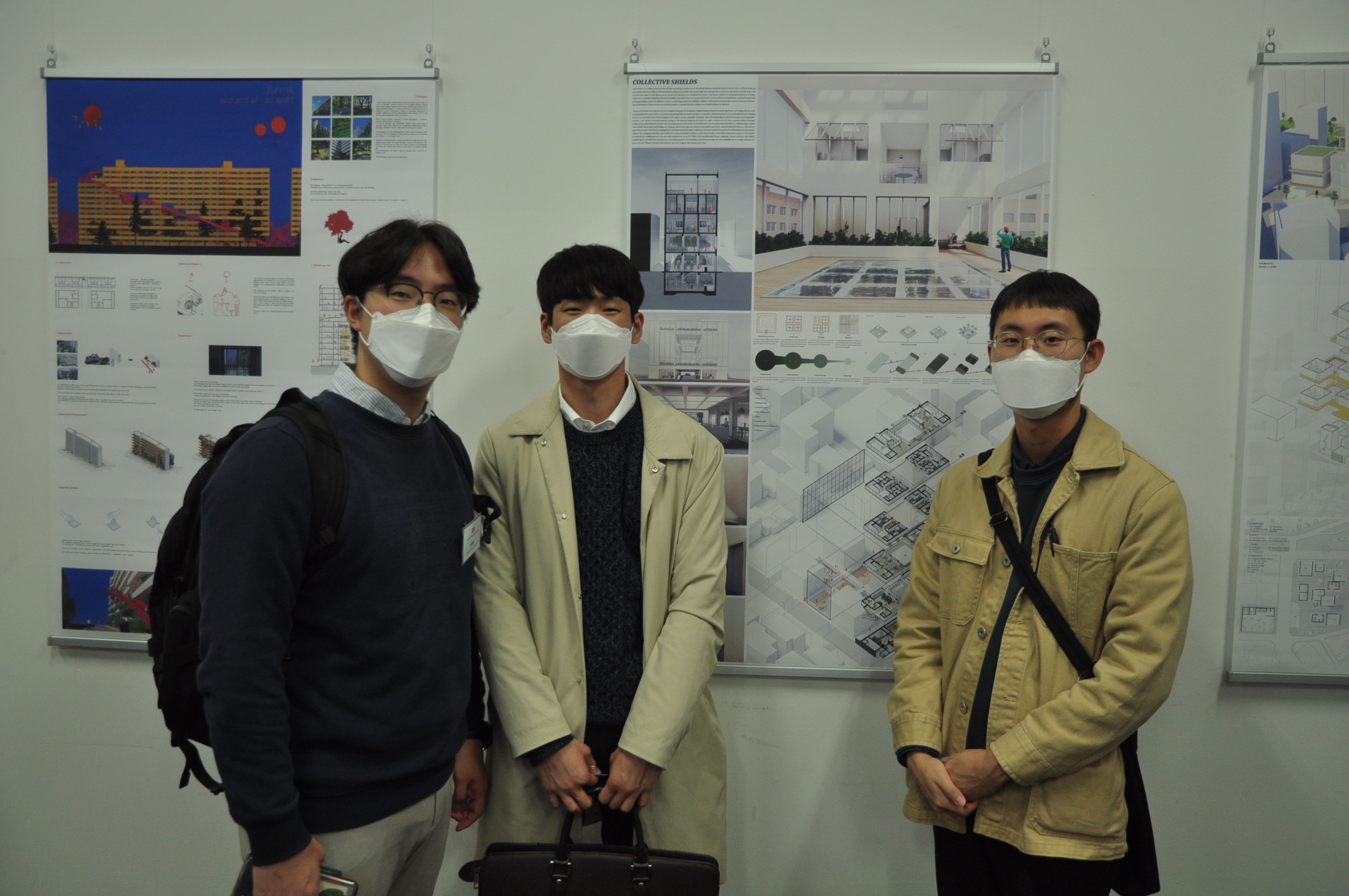
JEON, BYUNG HYUN
OH, MOON GYU
LEE, JONG GEUN
Hongik University
Sunmoon University
Yonsei University
COLLECTIVE_SHIELDS
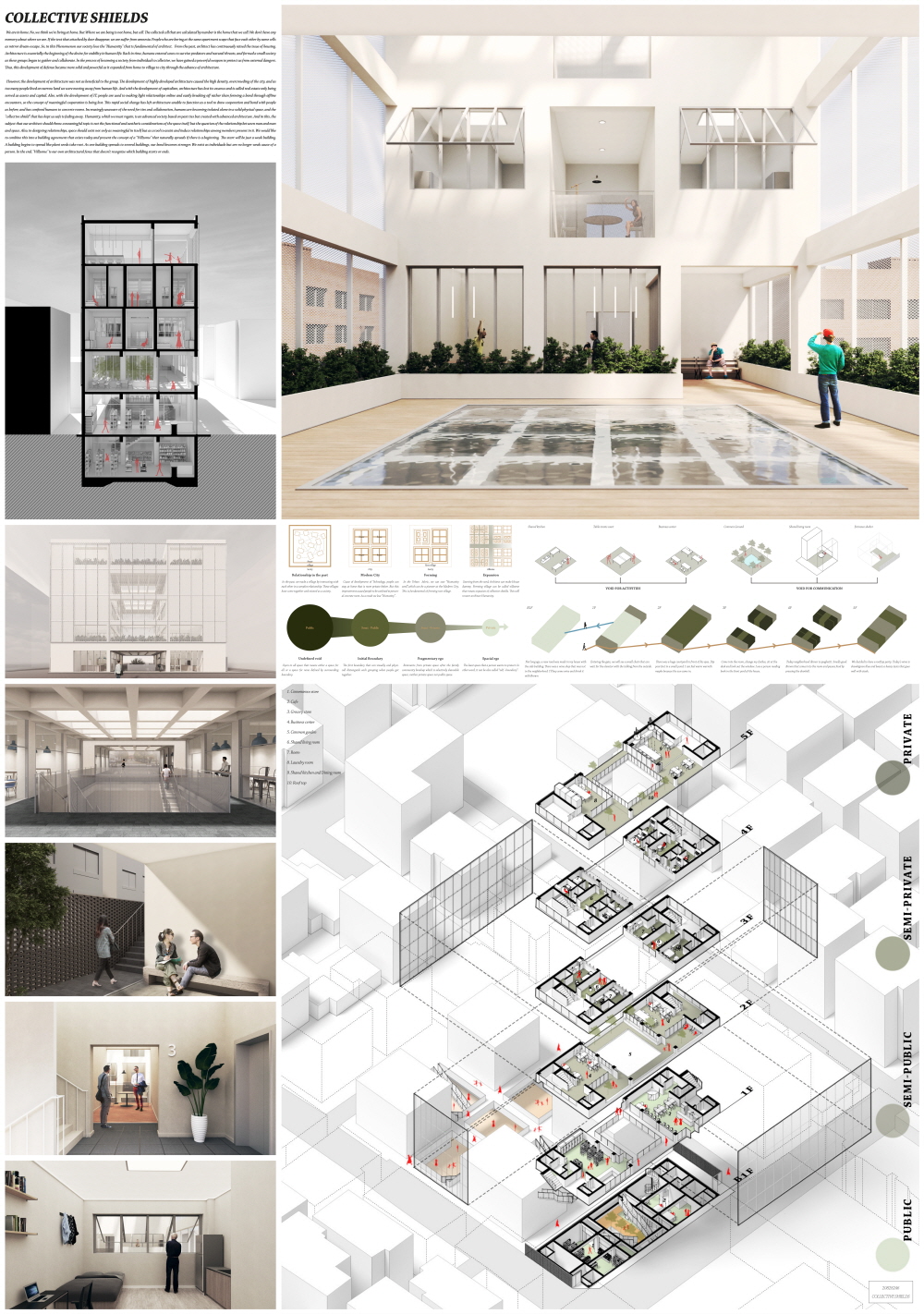
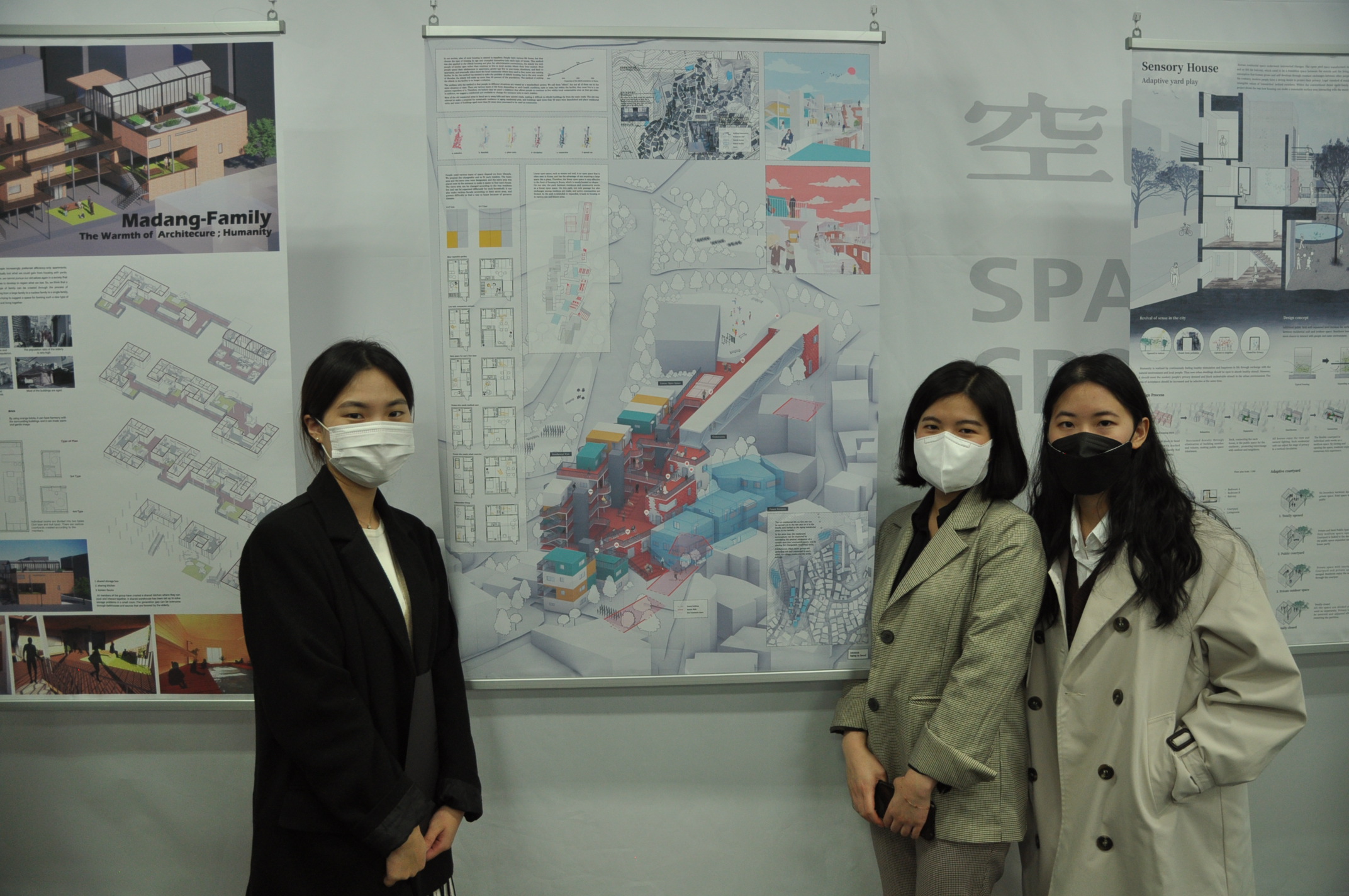
PARK, JI HYE
GWON, JAE HEE
HYUN, HA YOUNG
Seoul National University
Aging in Seoul
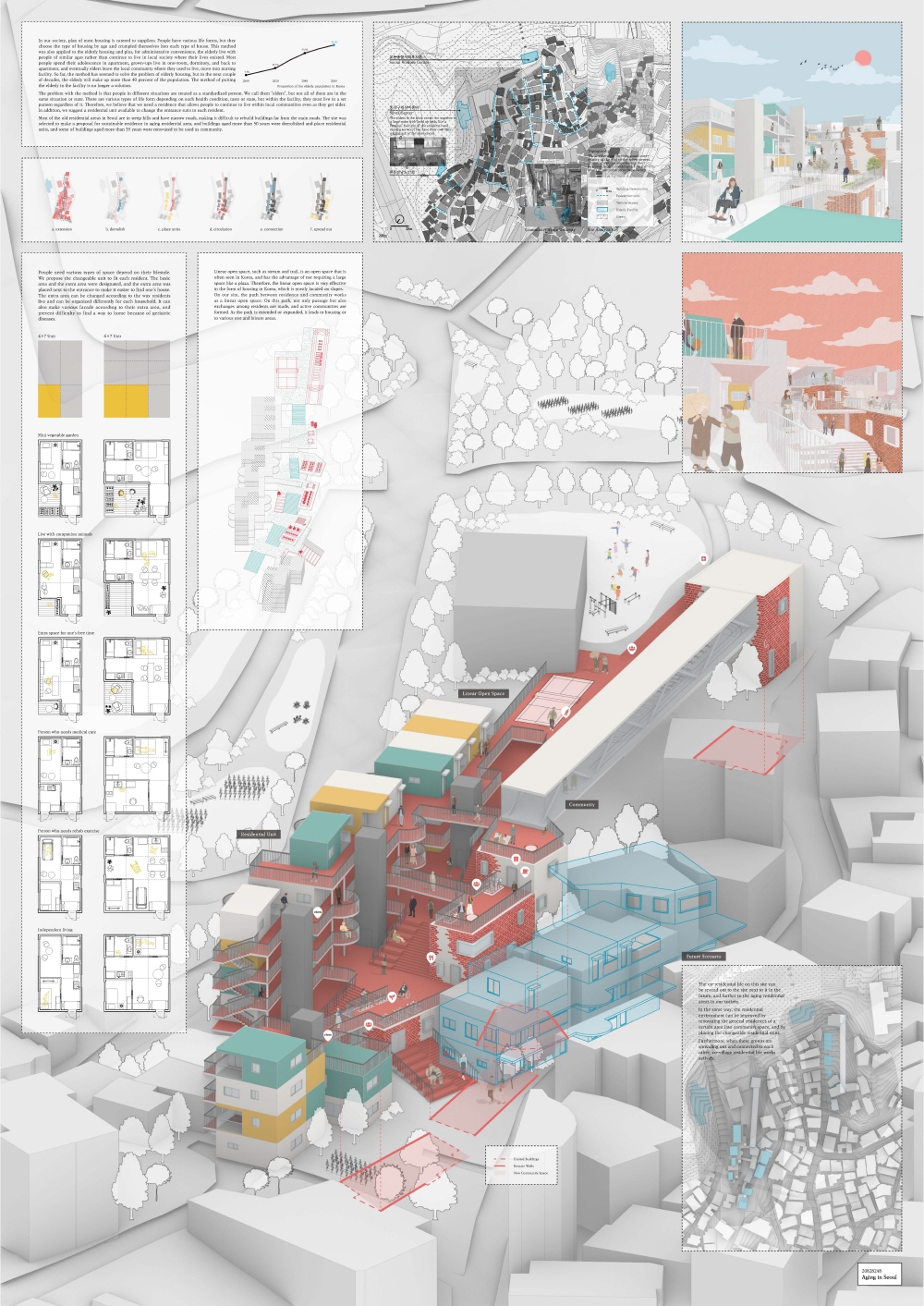
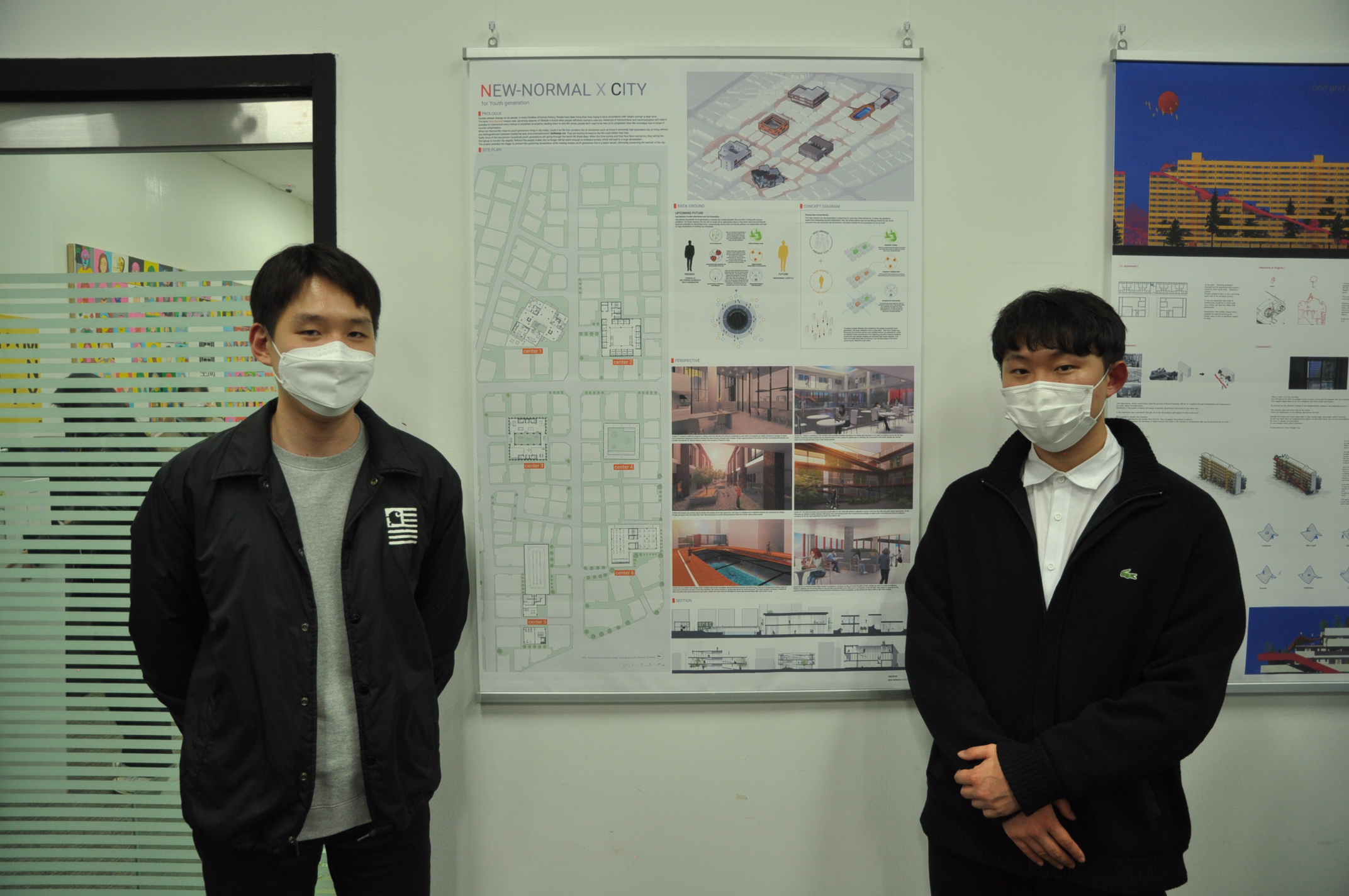
KIM, JO UN
YOON, SEONG HUN
CHOI, JAE WON
University of Seoul
NEW-NORMAL X CITY
